To attract hummingbirds to your garden provide a habitat that will give them food, water, shade, and shelter. Plant flowering shrubs, trees, perennials, annuals, and vines on which they can perch and nest, and from which they can get the nectar they need to thrive.
Hummingbirds rely on bright colors to find their food. Choose plants that are red–their favorite color–or orange-yellow. Tubular flowers hold the most nectar; be sure to include plenty of tubular flowers in your garden.
Hummingbirds need room to hover from flower to flower. Space plants far enough apart so that they can hover in front of blossoms with ease. A tiered habitat from ground to about 10 feet up will give them plenty of room to maneuver.
Include a water feature in the garden. Gently falling water or a light continuous spray is ideal. This will allow them to both drink and bathe.
Here are 40 plants that will attract hummingbirds to your garden:
Annuals
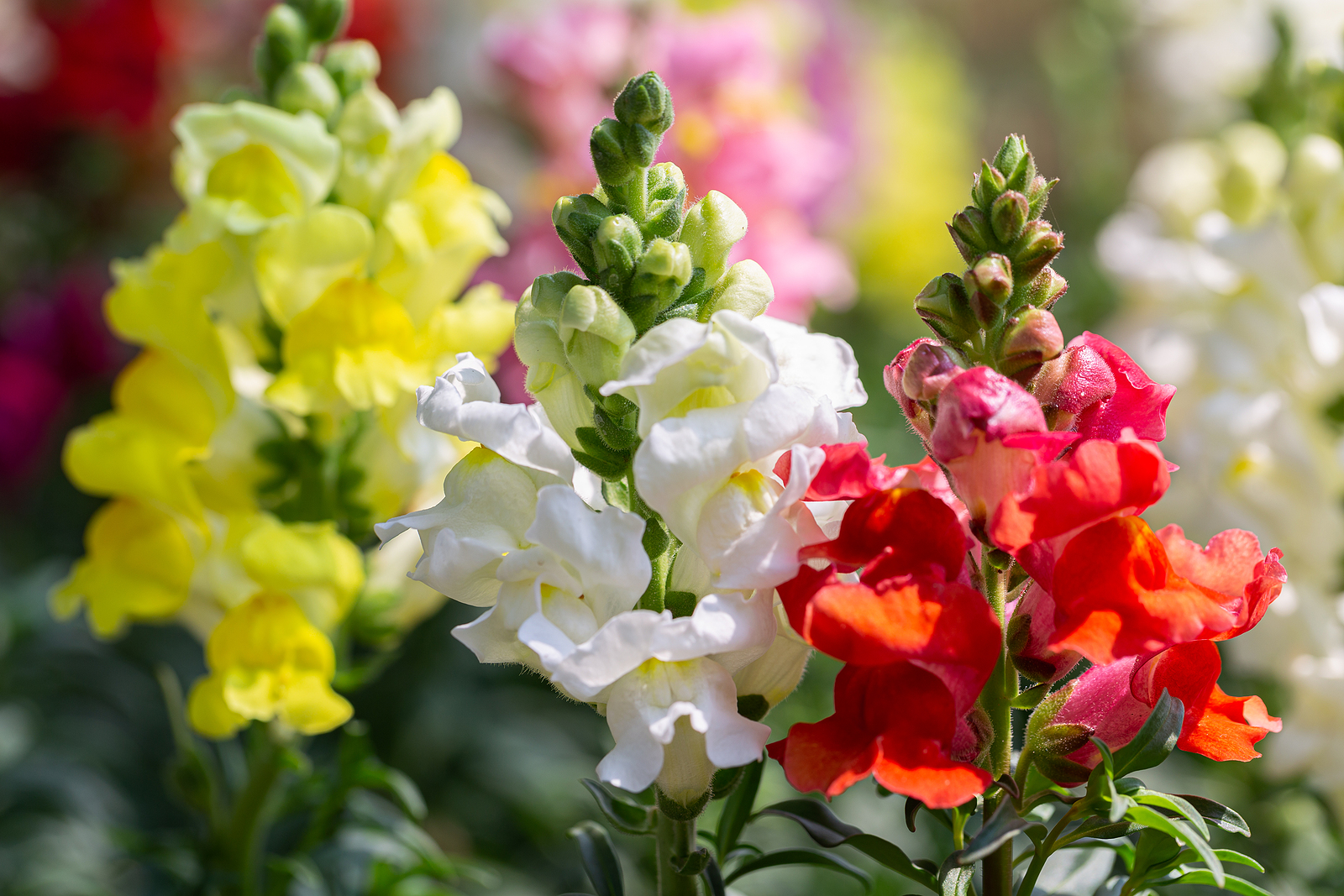 Antirrhinum majus (snapdragon). Spikes of closely set mostly single individual flowers that snap open when squeezed, hence the common name. Grows 7 inches to 3 feet tall. Sow seed outdoors in spring after the last frost or indoors 6 to 8 weeks before the last frost. Grow in full sun in fertile soil. Remove faded blooms for further flowering.
Antirrhinum majus (snapdragon). Spikes of closely set mostly single individual flowers that snap open when squeezed, hence the common name. Grows 7 inches to 3 feet tall. Sow seed outdoors in spring after the last frost or indoors 6 to 8 weeks before the last frost. Grow in full sun in fertile soil. Remove faded blooms for further flowering.
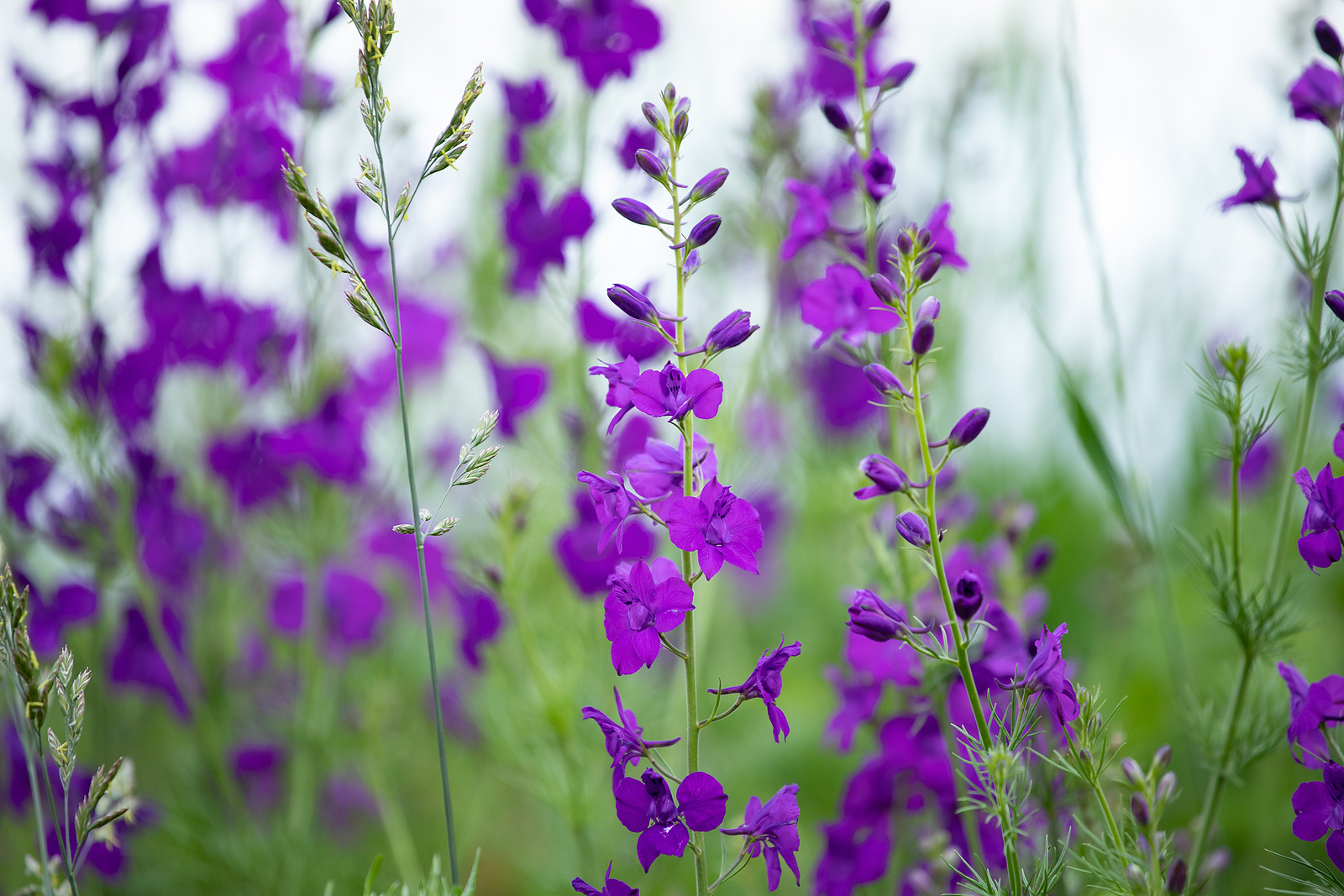 Consolida ambigua (rocket larkspur). Single or double flowers set along tall, tapering spikes with feathery, finely cut, bright green leaves. Grow 14 inches to 4 feet tall. Sow seed in spring or fall. Grows best in cool weather. Grow in full sun or partial shade, in average soil. Difficult to transplant.
Consolida ambigua (rocket larkspur). Single or double flowers set along tall, tapering spikes with feathery, finely cut, bright green leaves. Grow 14 inches to 4 feet tall. Sow seed in spring or fall. Grows best in cool weather. Grow in full sun or partial shade, in average soil. Difficult to transplant.
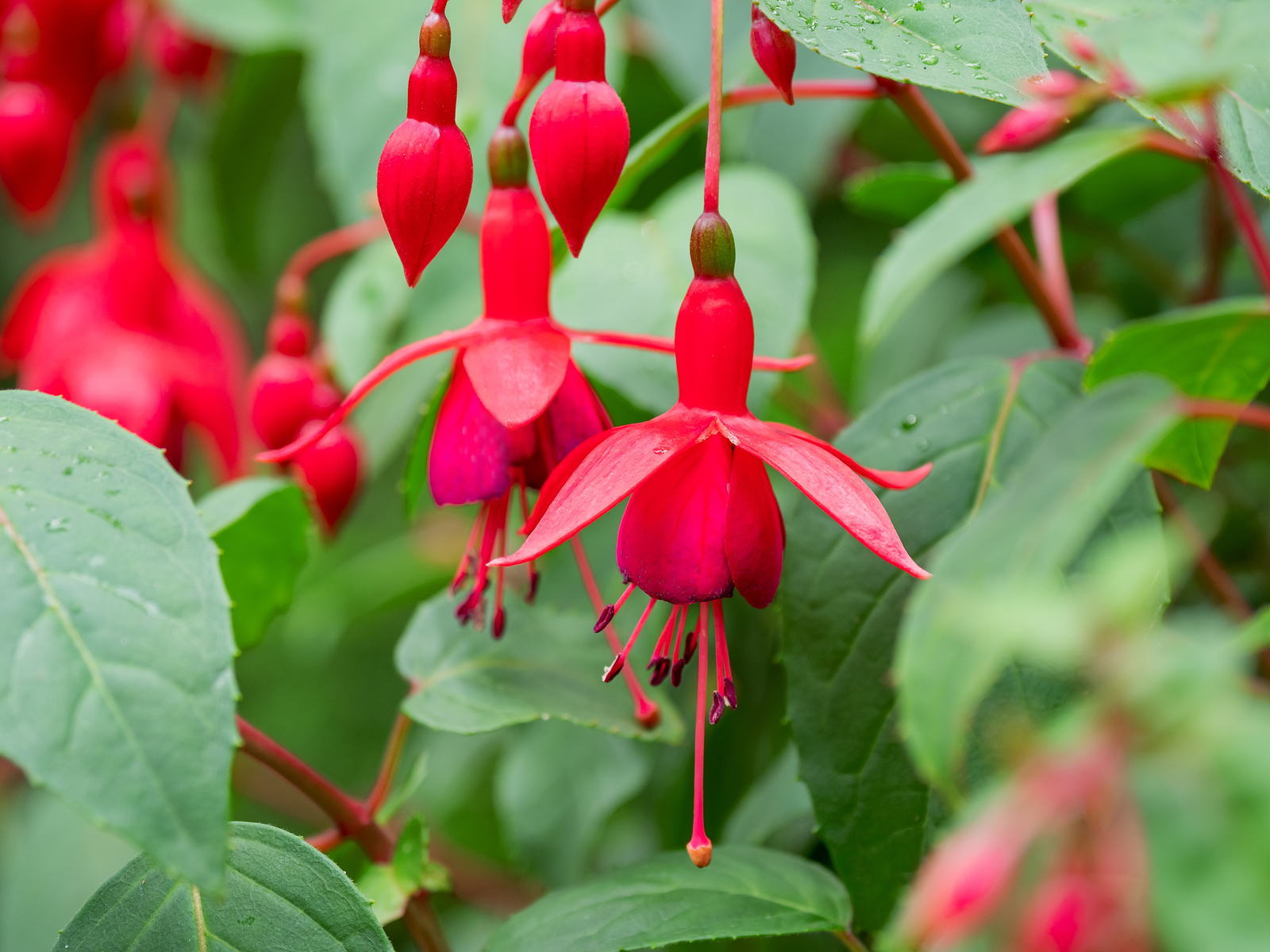 Fuchsia X hybrida (fuchsia). Open hanging blossoms form individually or in small clusters and begin to open in early to late summer in shades of purple, red, white, or blue. Grows to 18 inches tall and wide or more. Easy to grow in any good soil that is well-drained. Plant in partial shade. Start from seed or cuttings in spring.
Fuchsia X hybrida (fuchsia). Open hanging blossoms form individually or in small clusters and begin to open in early to late summer in shades of purple, red, white, or blue. Grows to 18 inches tall and wide or more. Easy to grow in any good soil that is well-drained. Plant in partial shade. Start from seed or cuttings in spring.
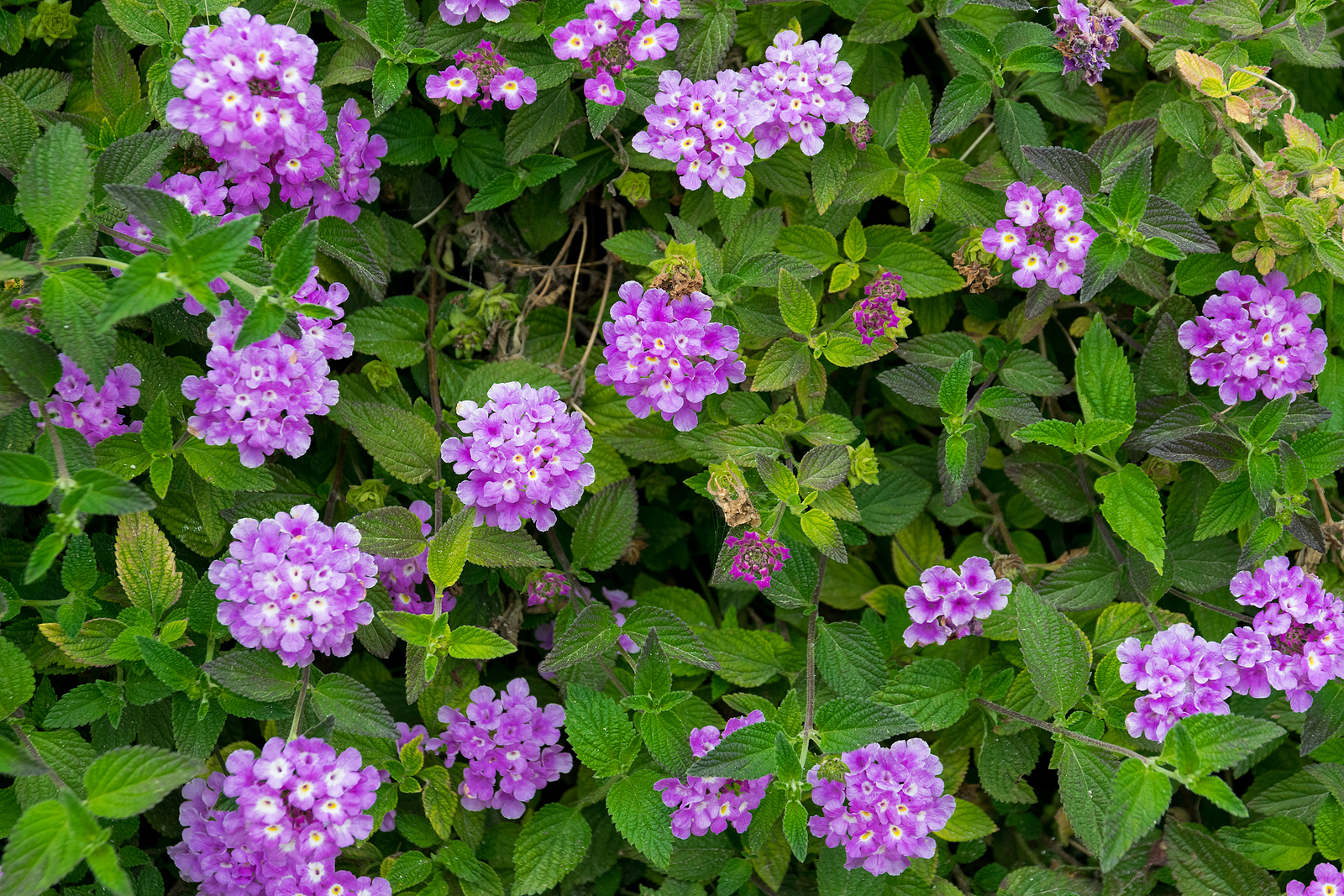 Lantana spp. (lantana). Masses of tiny flowers in dense heads form at the ends of branches or in junctures of leaves and stems. Grown as an annual in cold-winter climates or as shrub where no frost occurs. Grows 18 to 36 inches tall and wide. Grow in average soil in full sun. Take soft-shoot cuttings in spring or early summer.
Lantana spp. (lantana). Masses of tiny flowers in dense heads form at the ends of branches or in junctures of leaves and stems. Grown as an annual in cold-winter climates or as shrub where no frost occurs. Grows 18 to 36 inches tall and wide. Grow in average soil in full sun. Take soft-shoot cuttings in spring or early summer.
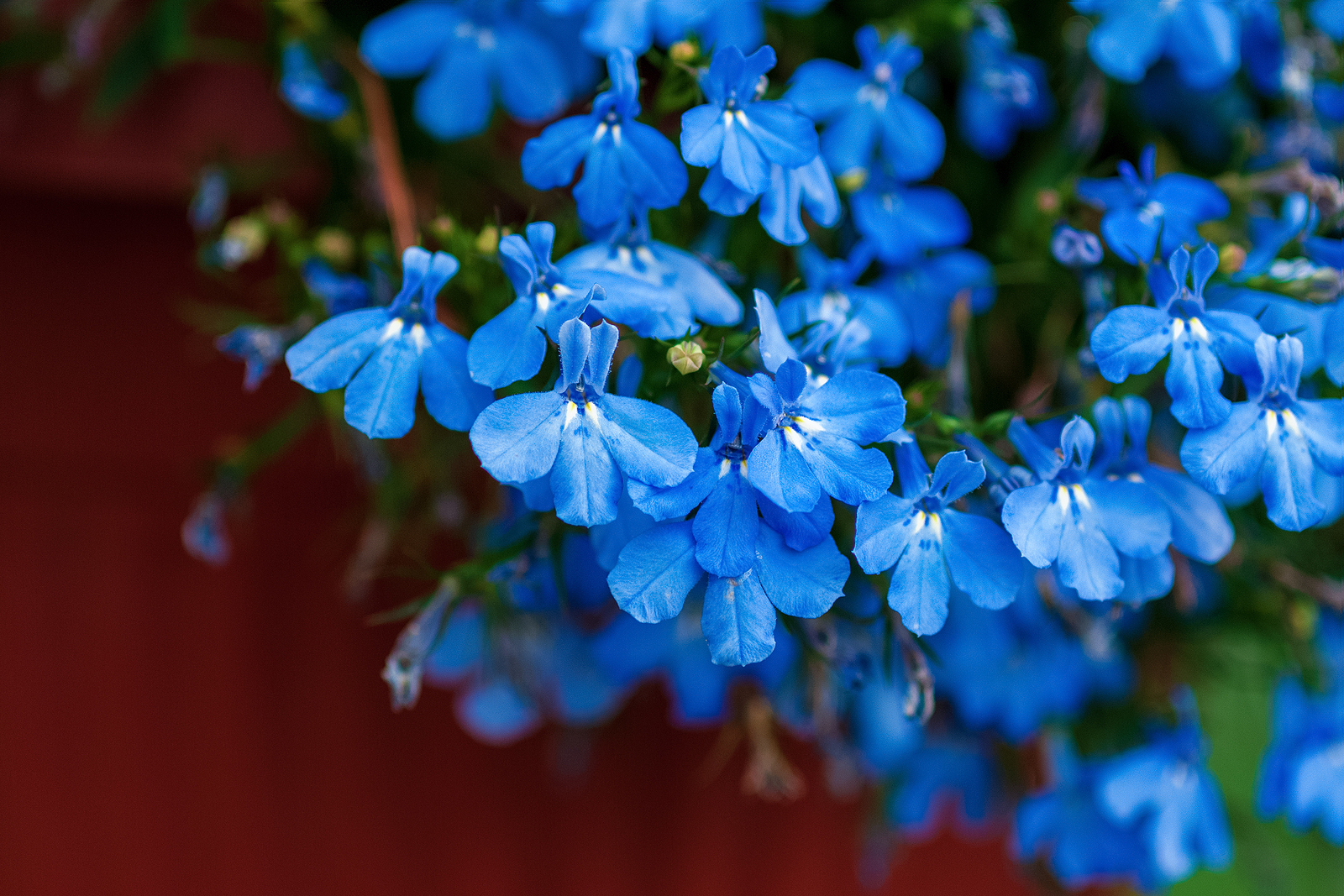 Lobelia erinus (edging lobelia). Small dark blue, violet-blue, or white 5-petaled flowers are borne in abundance over small bronze-green or green leaves. Grows 4 to 12 inches tall and wide. Direct sow or sow indoors 6 weeks before planting out. Grow in full sun in humus-rich soil. Excellent edging and container plant.
Lobelia erinus (edging lobelia). Small dark blue, violet-blue, or white 5-petaled flowers are borne in abundance over small bronze-green or green leaves. Grows 4 to 12 inches tall and wide. Direct sow or sow indoors 6 weeks before planting out. Grow in full sun in humus-rich soil. Excellent edging and container plant.
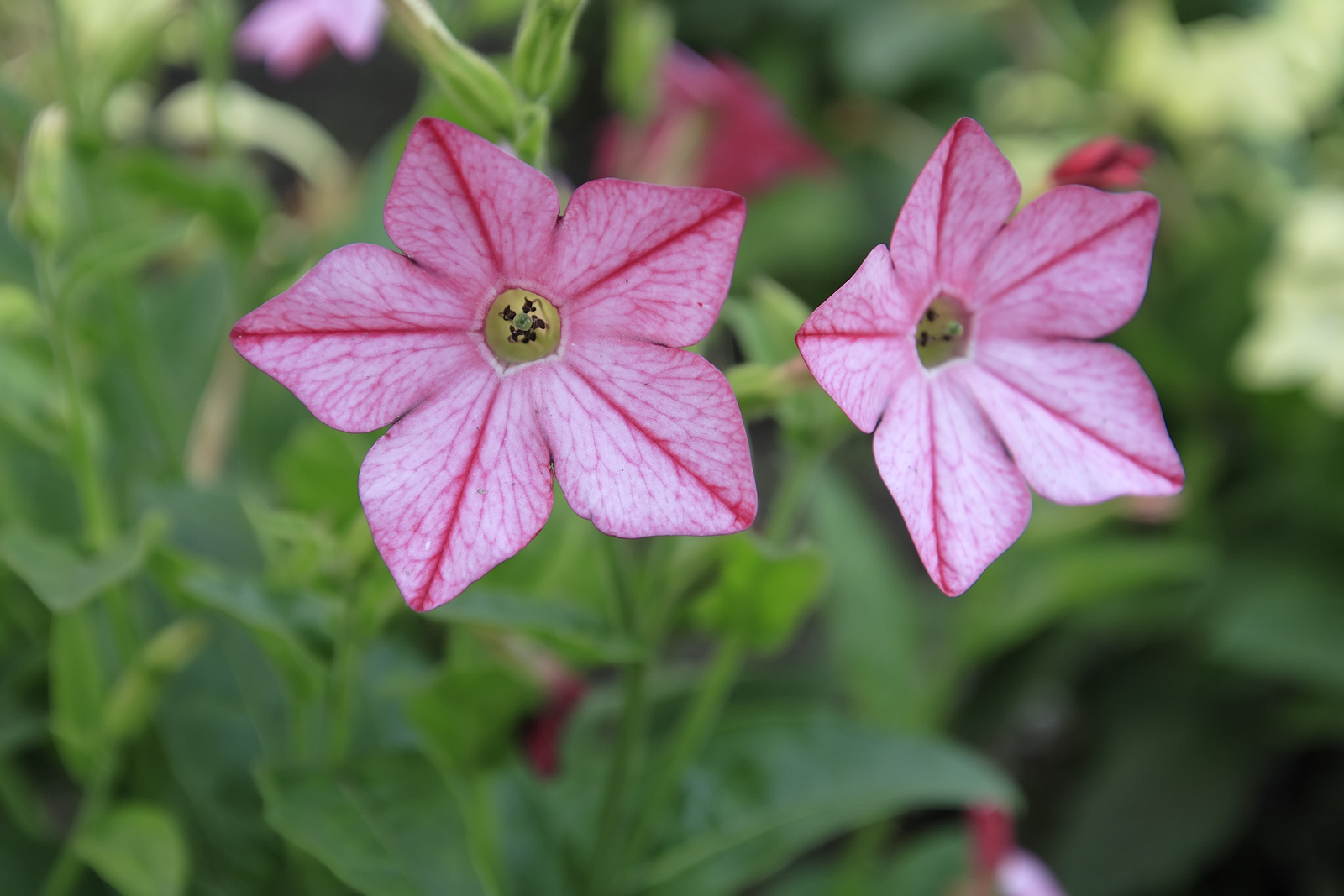 Nicotiana spp. (flowering tobacco). Clusters of fragrant, trumpet-shaped flowers above large basal leaves. Some close midday and open in the evening. Grows 10 to 30 inches tall and half as wide. Sow seeds indoors 8 to 10 weeks before the last spring frost; set seedlings outdoors after the last frost. Grow in full sun or partial shade. Tolerates heat.
Nicotiana spp. (flowering tobacco). Clusters of fragrant, trumpet-shaped flowers above large basal leaves. Some close midday and open in the evening. Grows 10 to 30 inches tall and half as wide. Sow seeds indoors 8 to 10 weeks before the last spring frost; set seedlings outdoors after the last frost. Grow in full sun or partial shade. Tolerates heat.
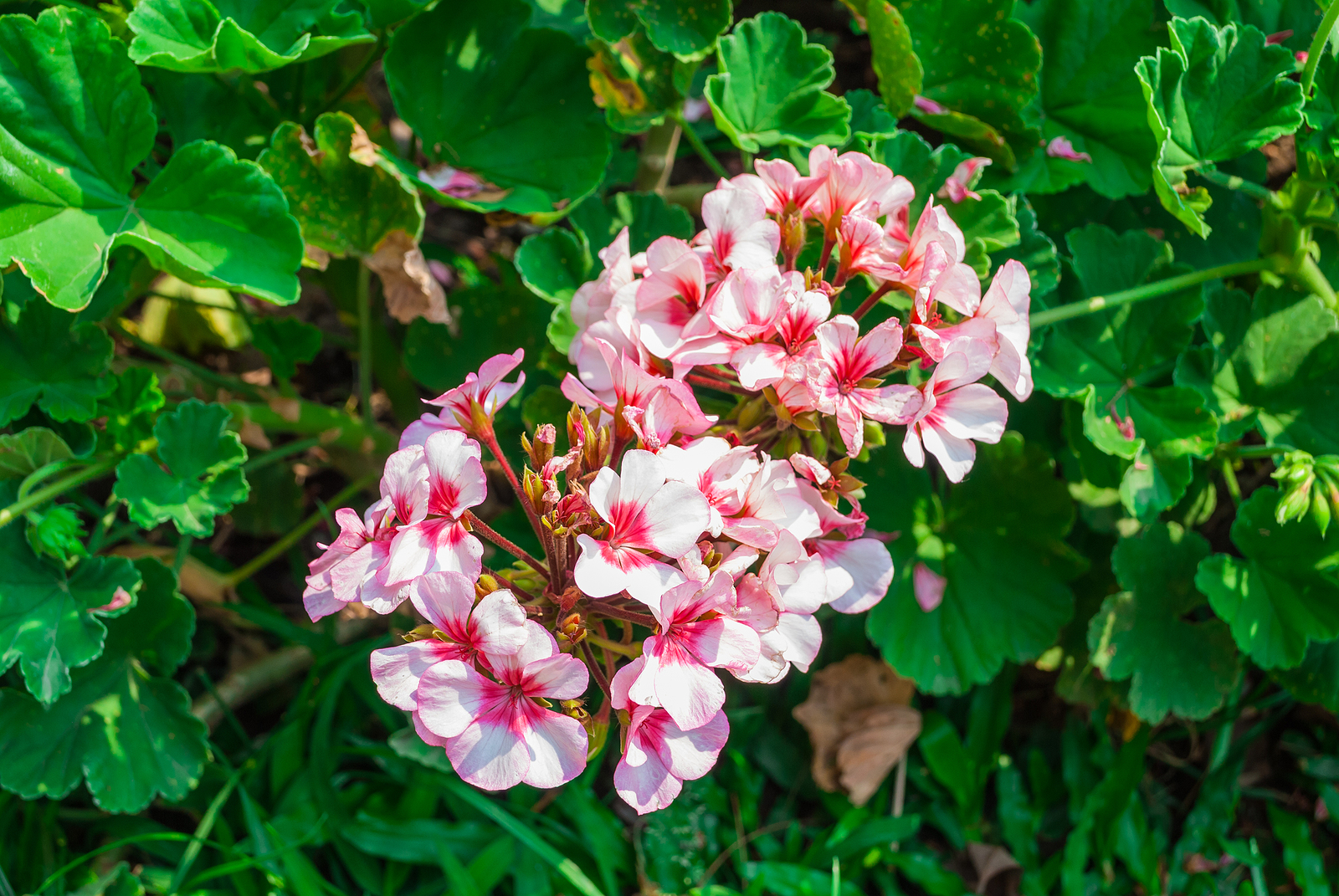 Pelargonium X hortorum (zonal geranium). Clusters of 2-inch flowers can be white, red, salmon, pink, lavender, orange, peach, bicolored or speckled. Blossoms appear from early summer to mid-fall. Grows 18 to 24 inches tall and wide. Plant in full sun or light shade in humus-rich, well-drained soil. Will overwinter in mild-winter regions.
Pelargonium X hortorum (zonal geranium). Clusters of 2-inch flowers can be white, red, salmon, pink, lavender, orange, peach, bicolored or speckled. Blossoms appear from early summer to mid-fall. Grows 18 to 24 inches tall and wide. Plant in full sun or light shade in humus-rich, well-drained soil. Will overwinter in mild-winter regions.
 Pelargonium peltatum (ivy geranium). Trailing plant with bright green deeply lobed leaves and clusters of vivid flowers that can be single or double–white, lavender, pink, rose, or red. Grows 12 to 24 inches (30-61cm) tall and 24 inches wide. Plant in full sun or light shade in humus-rich, well-drained soil. They have a long flowering period. Early pinching will promote branching.
Pelargonium peltatum (ivy geranium). Trailing plant with bright green deeply lobed leaves and clusters of vivid flowers that can be single or double–white, lavender, pink, rose, or red. Grows 12 to 24 inches (30-61cm) tall and 24 inches wide. Plant in full sun or light shade in humus-rich, well-drained soil. They have a long flowering period. Early pinching will promote branching.
 Petunia X hybrida (petunia). Large single or double flowers up to 5 inches across, some fringed, bordered, or streaked. Somewhat fragrant. Set out after last spring frost; sow seeds indoors 8 to 10 weeks before planting out. Grow in full sun and in average soil. Keep flowers picked for continued bloom.
Petunia X hybrida (petunia). Large single or double flowers up to 5 inches across, some fringed, bordered, or streaked. Somewhat fragrant. Set out after last spring frost; sow seeds indoors 8 to 10 weeks before planting out. Grow in full sun and in average soil. Keep flowers picked for continued bloom.
 Phlox drummondii (annual phlox). Dense heads of small 5-petaled flowers, some bicolored or fringed are borne over a long period. Grows 7 to 15 inches tall. Sow seeds outdoors as soon as the soil can be worked. Grow in full sun and in well-drained, slightly alkaline soil. Keep faded blooms picked to encourage further flowering.
Phlox drummondii (annual phlox). Dense heads of small 5-petaled flowers, some bicolored or fringed are borne over a long period. Grows 7 to 15 inches tall. Sow seeds outdoors as soon as the soil can be worked. Grow in full sun and in well-drained, slightly alkaline soil. Keep faded blooms picked to encourage further flowering.
 Salvia splendens (red salvia). Spikes of closely set flowering on bush plants bloom through summer. Easy to grow plants that are very showy. Grows 7 to 36 inches tall. Sow seeds indoors 4 to 6 weeks before the last spring frost, or sow outdoors when the weather warms. Grow in full sun in well-drained soil.
Salvia splendens (red salvia). Spikes of closely set flowering on bush plants bloom through summer. Easy to grow plants that are very showy. Grows 7 to 36 inches tall. Sow seeds indoors 4 to 6 weeks before the last spring frost, or sow outdoors when the weather warms. Grow in full sun in well-drained soil.
Bulbs
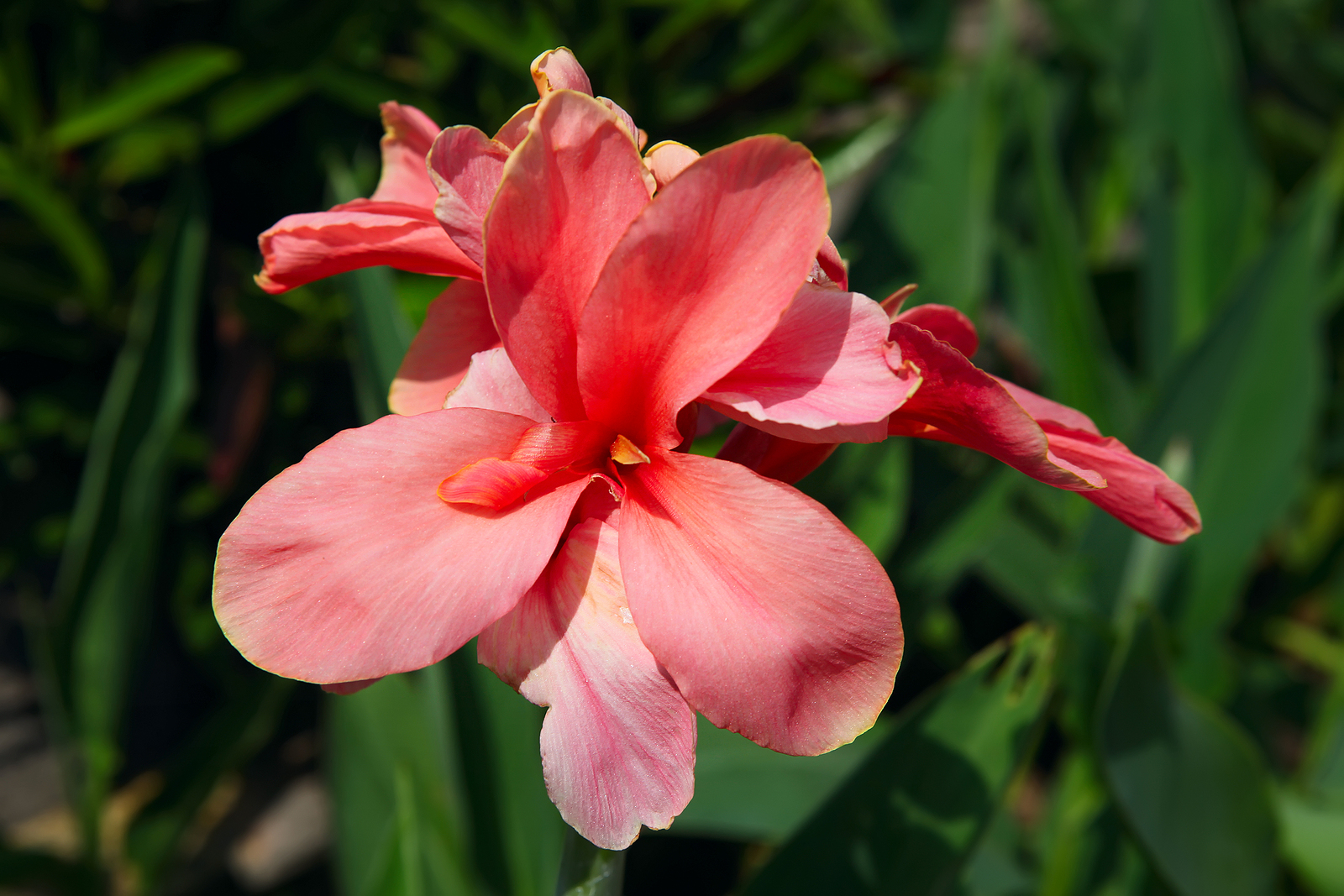 Canna X generalis (canna lily). Large flowers on spikes above very large leaves, colors range from white to shades of pink, yellow, and scarlet. Blooms in midsummer and grows best in long, hot summers. Grows 18 inches to 4 feet tall and half as wide. Plant rhizomes in spring after night temperatures stay above 50 degrees Fahrenheit or start indoors a month earlier.
Canna X generalis (canna lily). Large flowers on spikes above very large leaves, colors range from white to shades of pink, yellow, and scarlet. Blooms in midsummer and grows best in long, hot summers. Grows 18 inches to 4 feet tall and half as wide. Plant rhizomes in spring after night temperatures stay above 50 degrees Fahrenheit or start indoors a month earlier.
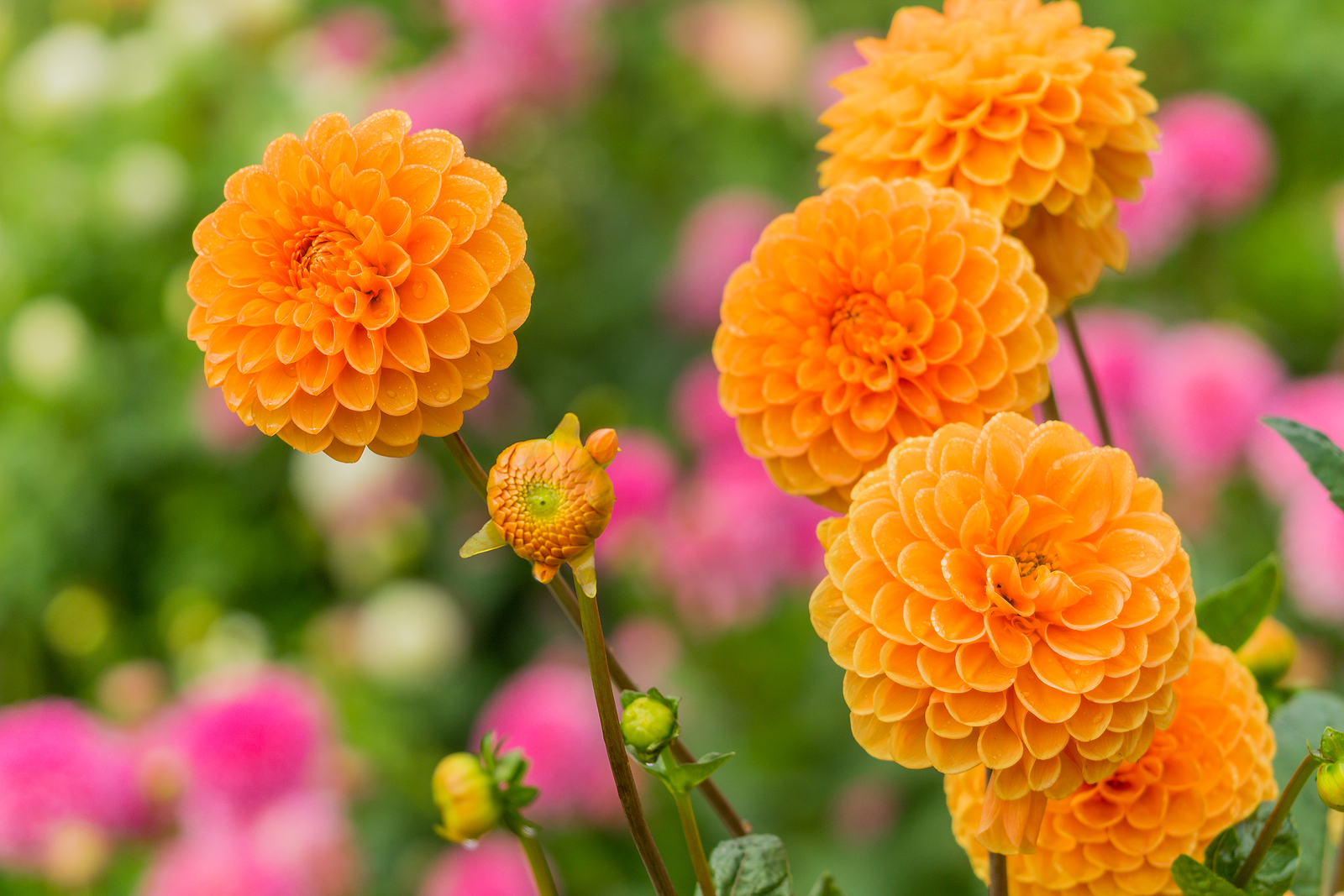 Dahlia pinnata (dahlia). One of the garden’s showiest flowers blooms in late summer to early fall; blooms in every color but blue. Grows from 2 to 4 feet tall. Plant tubers in spring after the soil has warmed. Plant in sun or midday shade in hot summer regions. Plant in humus-rich, well-drained soil with abundant moisture.
Dahlia pinnata (dahlia). One of the garden’s showiest flowers blooms in late summer to early fall; blooms in every color but blue. Grows from 2 to 4 feet tall. Plant tubers in spring after the soil has warmed. Plant in sun or midday shade in hot summer regions. Plant in humus-rich, well-drained soil with abundant moisture.
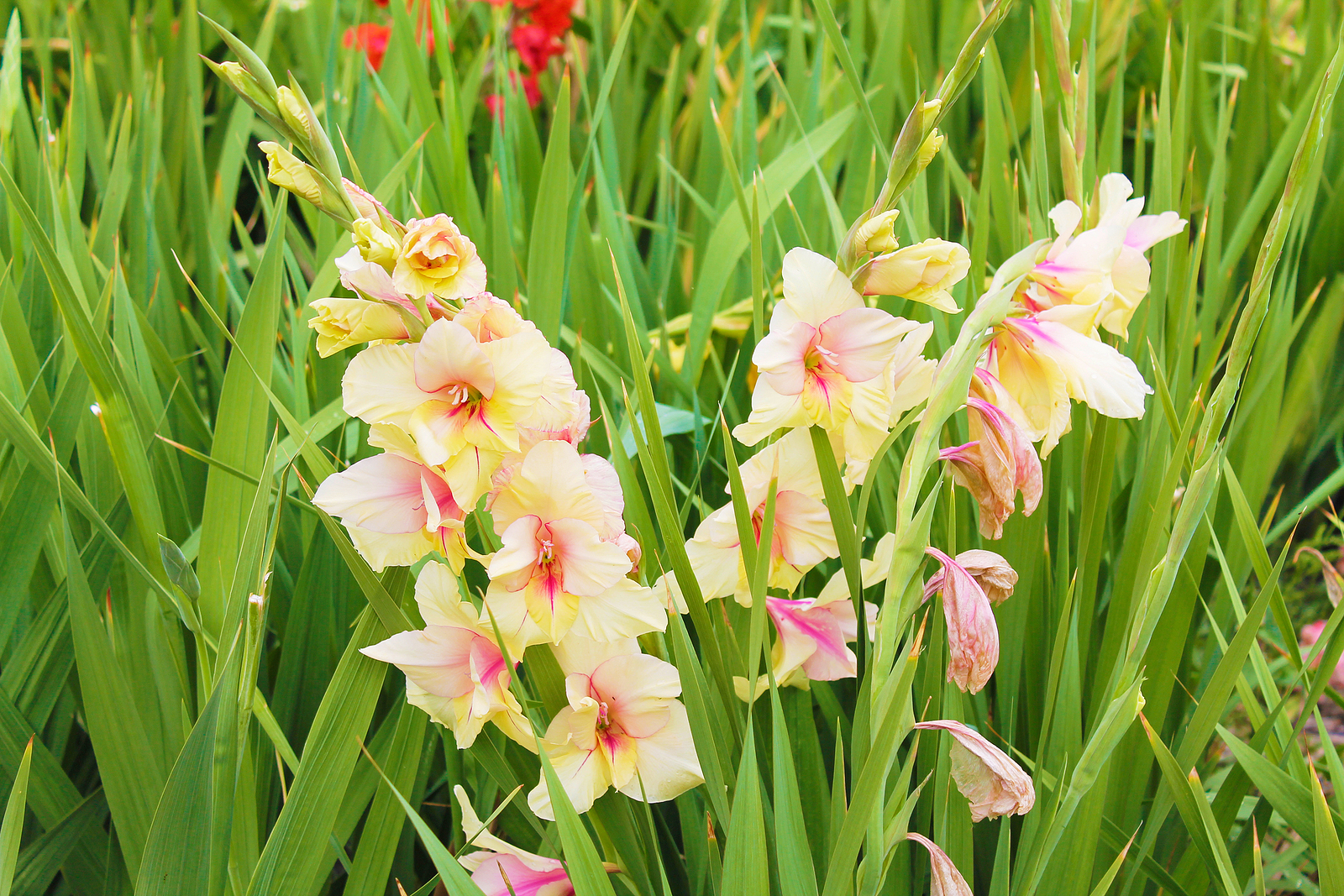 Gladiolus hybrids (gladiolus). Comes in a range of sizes from 18 inches to 6 feet tall. Flowers come in all colors of the spectrum, many bicolored. Bloom time depends on climate; summer in cold regions, all months in mild regions. Plant corms in humus-rich, well-drained soil in full sun. Dig and store corms in cold-winter regions.
Gladiolus hybrids (gladiolus). Comes in a range of sizes from 18 inches to 6 feet tall. Flowers come in all colors of the spectrum, many bicolored. Bloom time depends on climate; summer in cold regions, all months in mild regions. Plant corms in humus-rich, well-drained soil in full sun. Dig and store corms in cold-winter regions.
Perennials and biennials
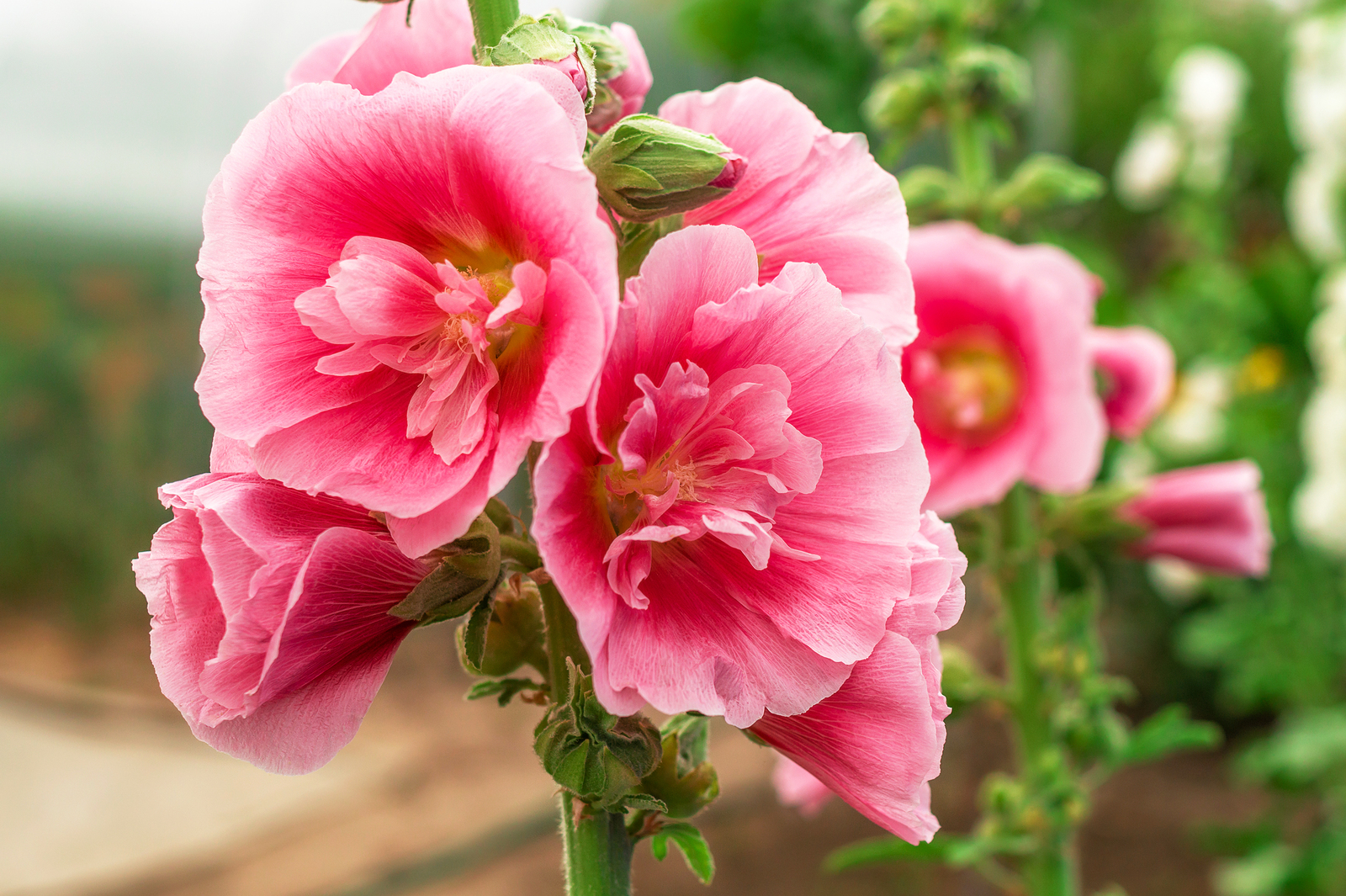 Alcea rosea (hollyhock). Biennial produces 5-inch flowers on long stalks; blooms unfurl progressing from the bottom toward the top producing a summer of display. Flowers may be single, double, or semidouble in yellow, white, rose, pink, red, lavender, and almost black. Old-fashioned types can grow to 12 feet tall, modern hybrids from 2 to 8 feet tall. Plant in full sun in humus-rich, well-drained soil. Sow seeds in early summer for bloom the next summer.
Alcea rosea (hollyhock). Biennial produces 5-inch flowers on long stalks; blooms unfurl progressing from the bottom toward the top producing a summer of display. Flowers may be single, double, or semidouble in yellow, white, rose, pink, red, lavender, and almost black. Old-fashioned types can grow to 12 feet tall, modern hybrids from 2 to 8 feet tall. Plant in full sun in humus-rich, well-drained soil. Sow seeds in early summer for bloom the next summer.
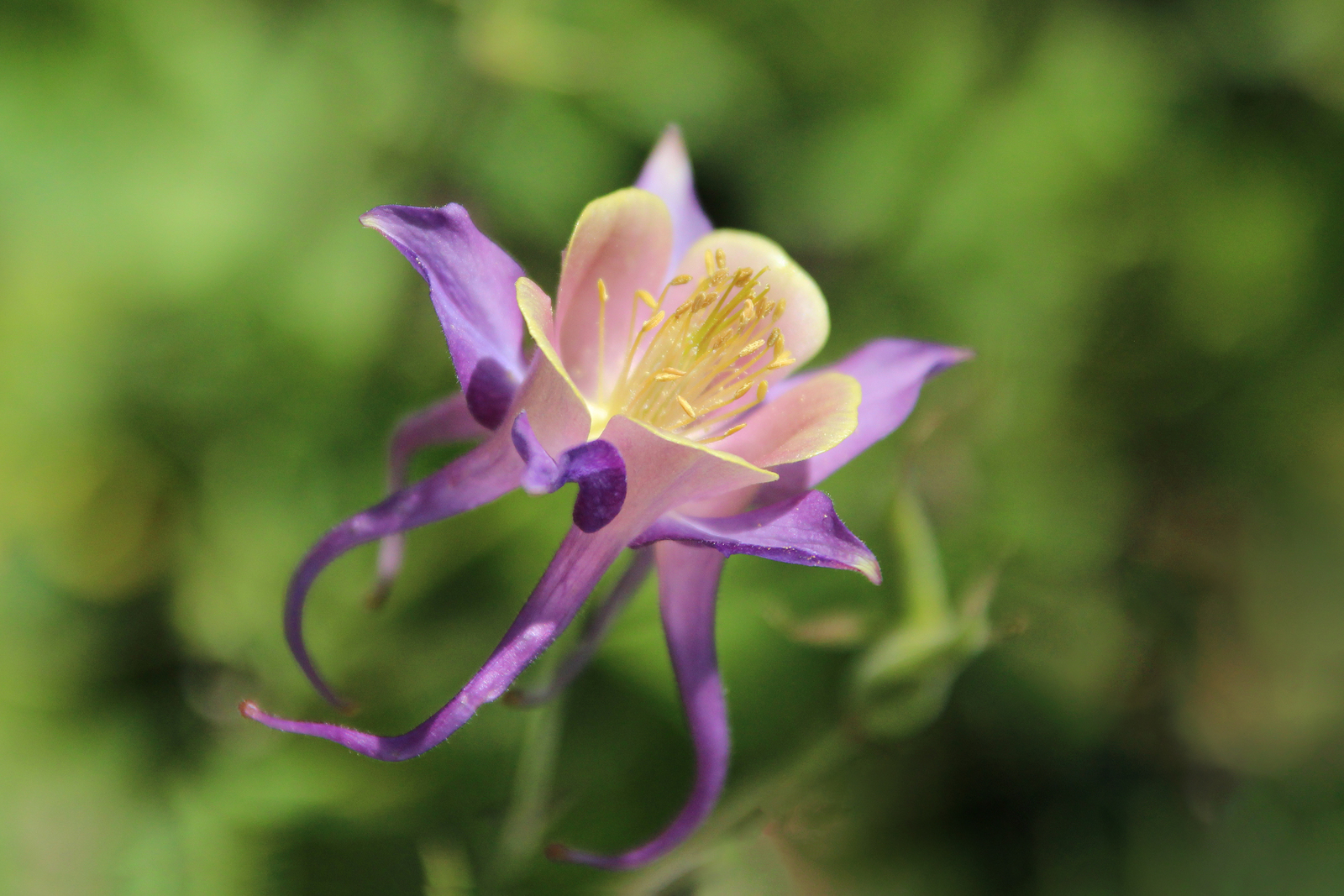 Aquilegia spp. (columbine). Graceful plant that bears funnel-shaped flowers with prominent spurs in late spring. Grows 15 inches to 3 feet tall and half as wide. Grow in sun or partial shade, in moist, well-drained soil. Will self-sow. Propagate by seeds in early spring.
Aquilegia spp. (columbine). Graceful plant that bears funnel-shaped flowers with prominent spurs in late spring. Grows 15 inches to 3 feet tall and half as wide. Grow in sun or partial shade, in moist, well-drained soil. Will self-sow. Propagate by seeds in early spring.
 Asclepias tuberosa (butterfly weed). Trouble-free perennials native to prairies across North America bears clusters of orange flowers in midsummer. Grows to 24 inches tall; can remain in place for years. Grows 24 to 36 tall. Plant in full sun in average to sandy soil. Sow seed in fall or container-grown plants in spring.
Asclepias tuberosa (butterfly weed). Trouble-free perennials native to prairies across North America bears clusters of orange flowers in midsummer. Grows to 24 inches tall; can remain in place for years. Grows 24 to 36 tall. Plant in full sun in average to sandy soil. Sow seed in fall or container-grown plants in spring.
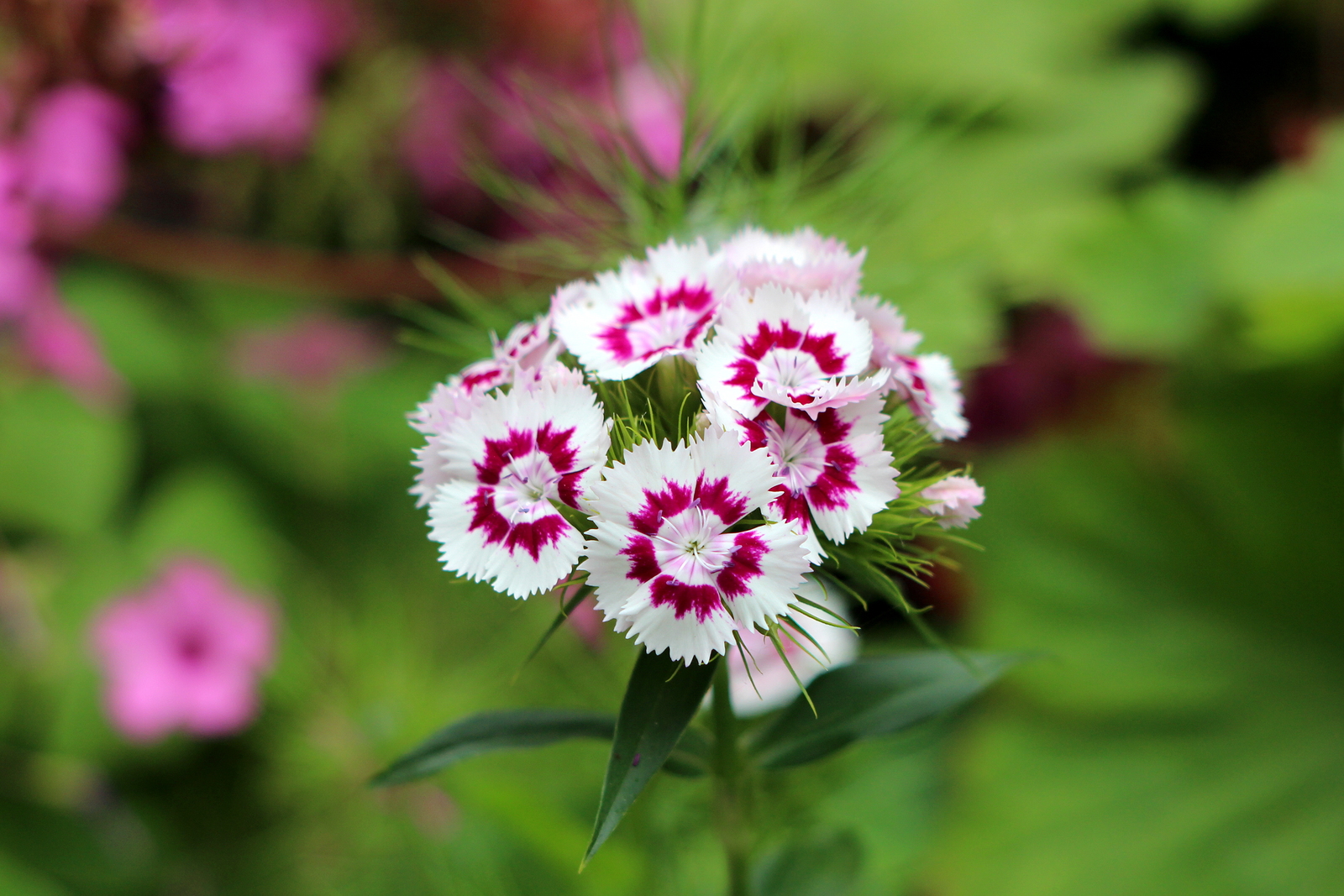 Dianthus barbatus (sweet William). Single to double flowers bloom over a long period in pink, red, or white. Grows 4 to 24 inches tall. Plant in full sun to light shade in average to rich, well-drained slightly alkaline soil. Grows best in cool weather, autumn or spring. Keep faded flowers picked to prolong bloom. Sow seed in spring.
Dianthus barbatus (sweet William). Single to double flowers bloom over a long period in pink, red, or white. Grows 4 to 24 inches tall. Plant in full sun to light shade in average to rich, well-drained slightly alkaline soil. Grows best in cool weather, autumn or spring. Keep faded flowers picked to prolong bloom. Sow seed in spring.
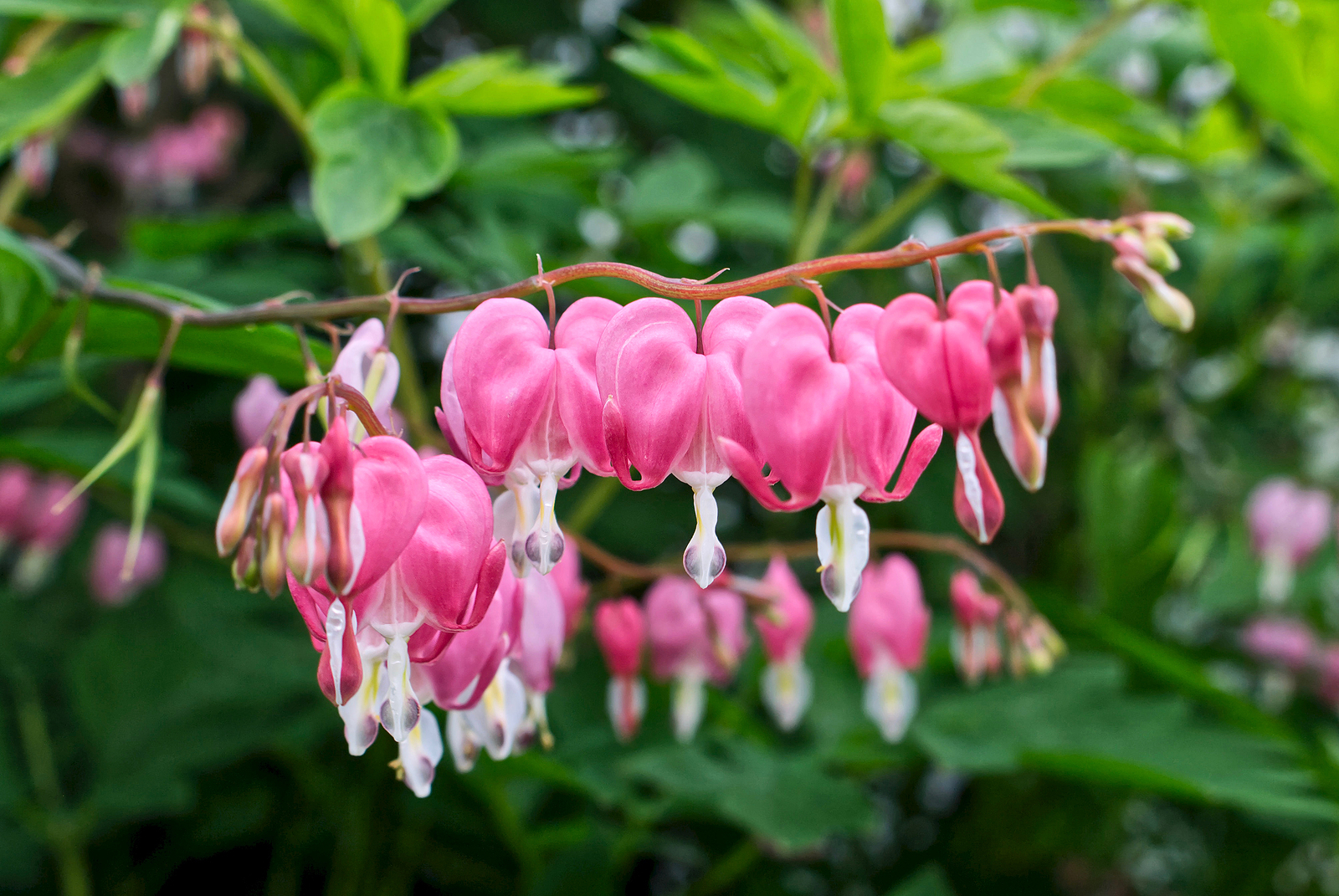 Dicentra spp. (bleeding-heart). Graceful plant with pendulous heart-shaped flowers blooming on arching stems in late spring. Flowers range from pink to red to white. Grows 12 to 30 inches tall and about as wide. Grow in humus-rich soil in sun or shade.
Dicentra spp. (bleeding-heart). Graceful plant with pendulous heart-shaped flowers blooming on arching stems in late spring. Flowers range from pink to red to white. Grows 12 to 30 inches tall and about as wide. Grow in humus-rich soil in sun or shade.
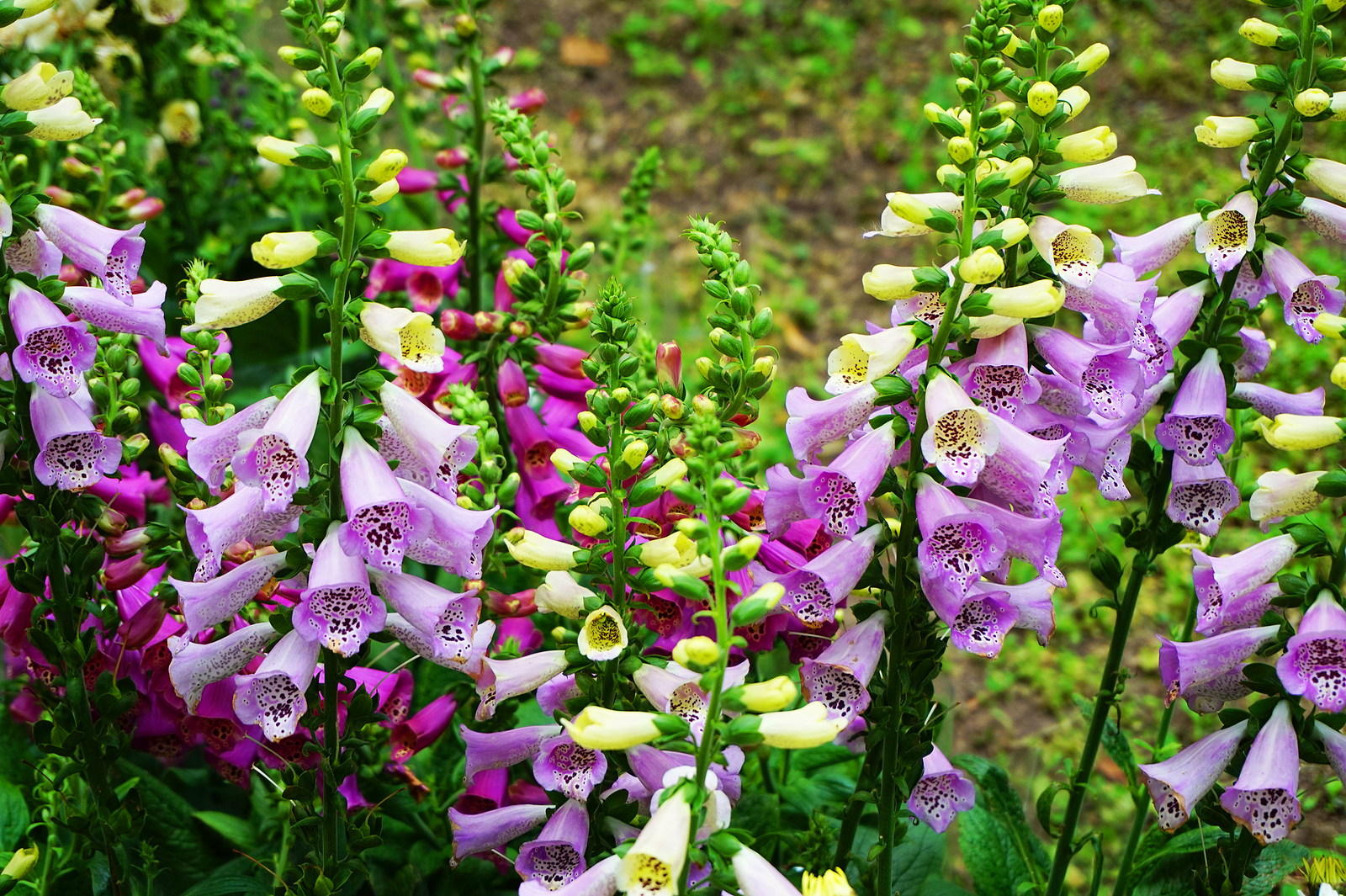 Digitalis spp. (foxglove). Tall spikes of closely set tubular flowers. Blooms can be white, purple, pink, rose, and yellow. Generally grown as a biennial. Grows 3 to 5 feet tall. Sow early indoors for bloom same season or outdoors in late summer for bloom next year. Grow in partial shade in well-drained, moisture-retentive soil.
Digitalis spp. (foxglove). Tall spikes of closely set tubular flowers. Blooms can be white, purple, pink, rose, and yellow. Generally grown as a biennial. Grows 3 to 5 feet tall. Sow early indoors for bloom same season or outdoors in late summer for bloom next year. Grow in partial shade in well-drained, moisture-retentive soil.
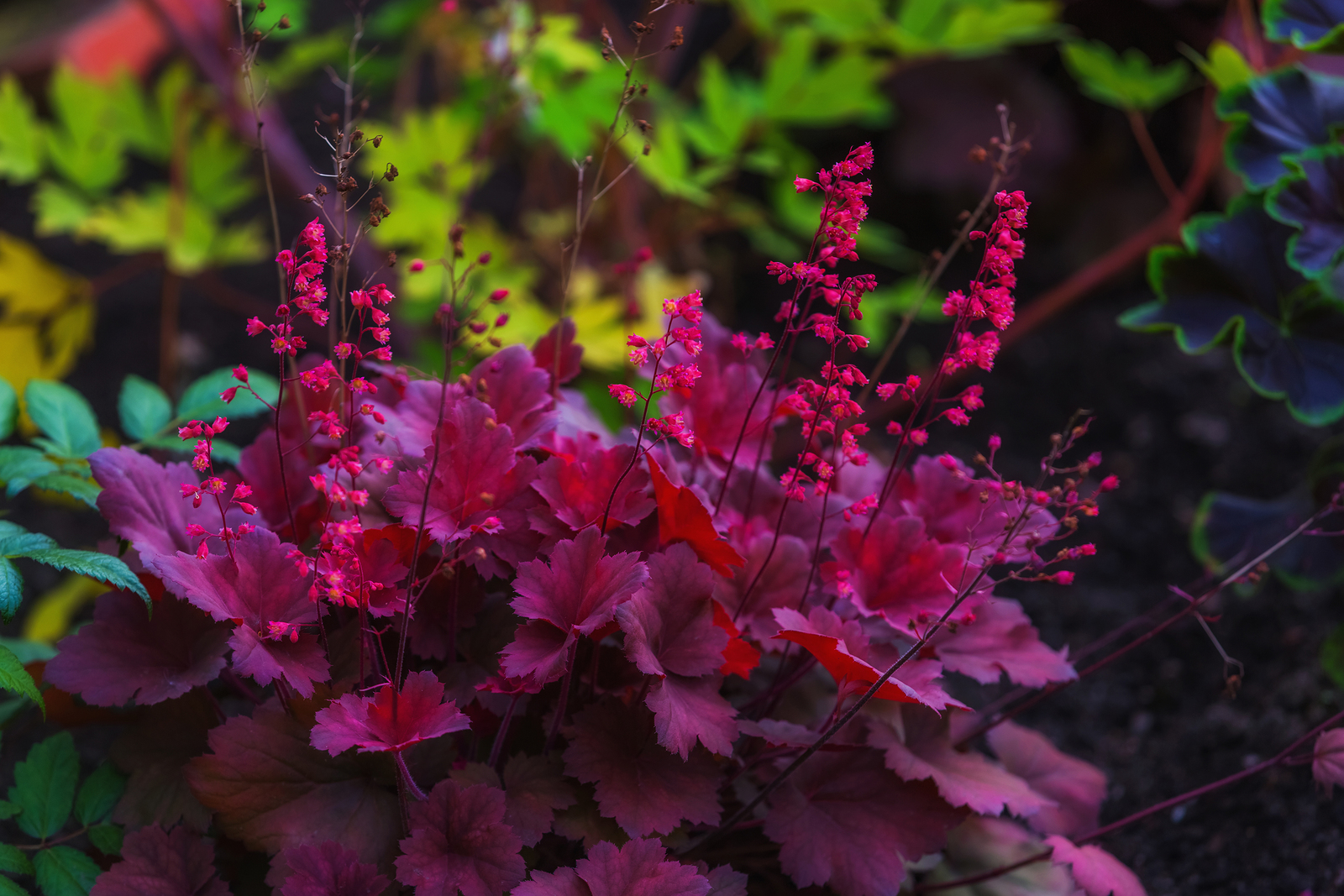 Heuchera spp. (coral bells). Small bell-shaped flowers on slender stems in early summer. Flowers are white and shades of pink and red. Grows 12 to 24 inches tall. Plant in spring in sun or partial shade in humus-rich, well-drained soil. Divide in spring; sow seeds in spring.
Heuchera spp. (coral bells). Small bell-shaped flowers on slender stems in early summer. Flowers are white and shades of pink and red. Grows 12 to 24 inches tall. Plant in spring in sun or partial shade in humus-rich, well-drained soil. Divide in spring; sow seeds in spring.
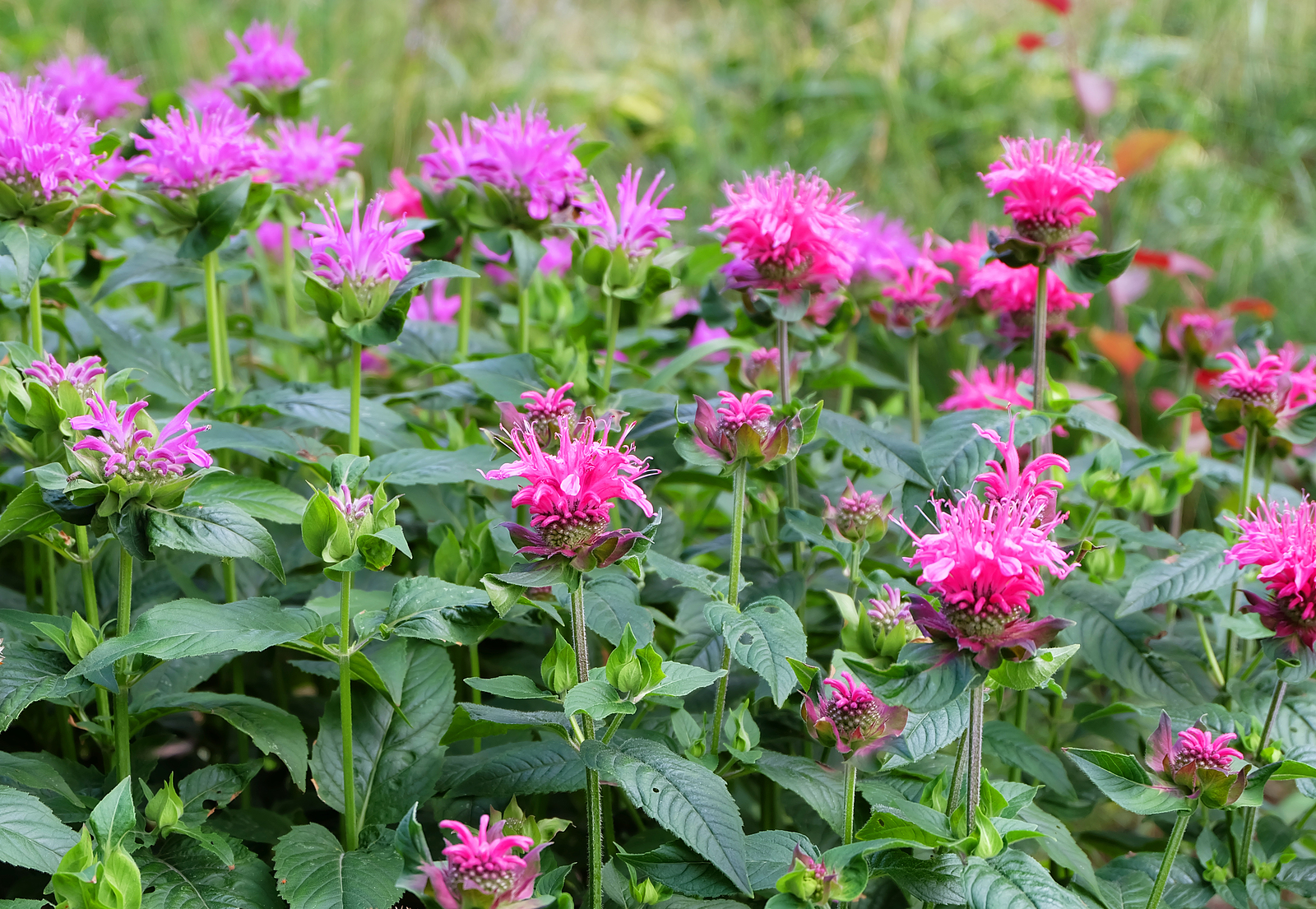 Monarda didyma (beebalm). Tubular flowers in crowded clusters bloom in mid to late summer. Grows 24 to 36 inches tall. Plant in full sun, but will grow in partial shade. Tolerates dry soil but grows best with plenty of moisture during the summer. Sow seeds in spring. Divide plants in spring; divide plants every three years for maximum bloom.
Monarda didyma (beebalm). Tubular flowers in crowded clusters bloom in mid to late summer. Grows 24 to 36 inches tall. Plant in full sun, but will grow in partial shade. Tolerates dry soil but grows best with plenty of moisture during the summer. Sow seeds in spring. Divide plants in spring; divide plants every three years for maximum bloom.
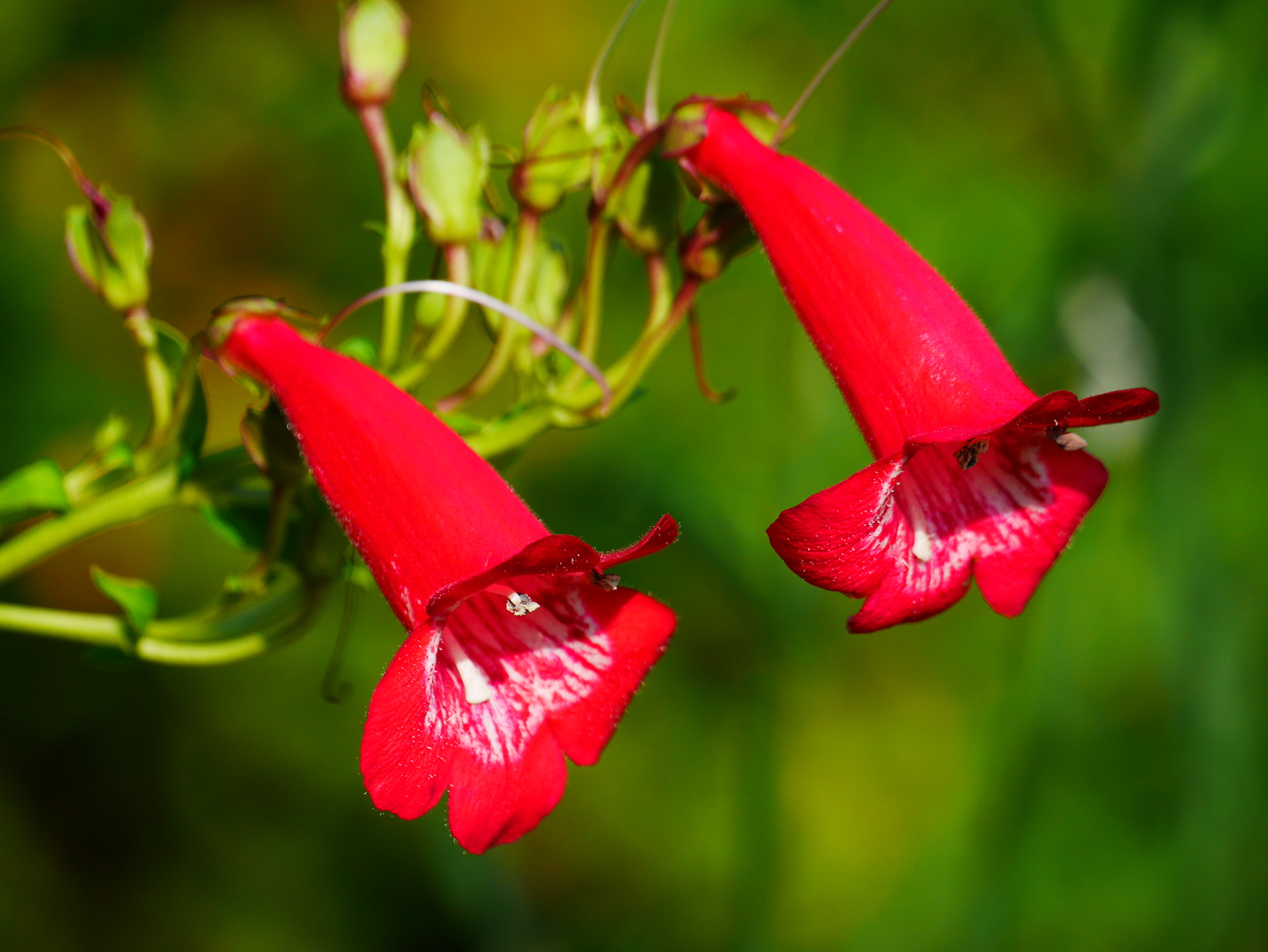 Penstemon spp. (beard-tongue). Spikes of foxglove-shaped flowers in mid to later summer. Blooms in shades of pink to red and orange. Grows 12 to 24 inches tall. Plant in full sun and well-drained soil. Keep faded flowers picked to encourage further blooming. Sow seed in spring.
Penstemon spp. (beard-tongue). Spikes of foxglove-shaped flowers in mid to later summer. Blooms in shades of pink to red and orange. Grows 12 to 24 inches tall. Plant in full sun and well-drained soil. Keep faded flowers picked to encourage further blooming. Sow seed in spring.
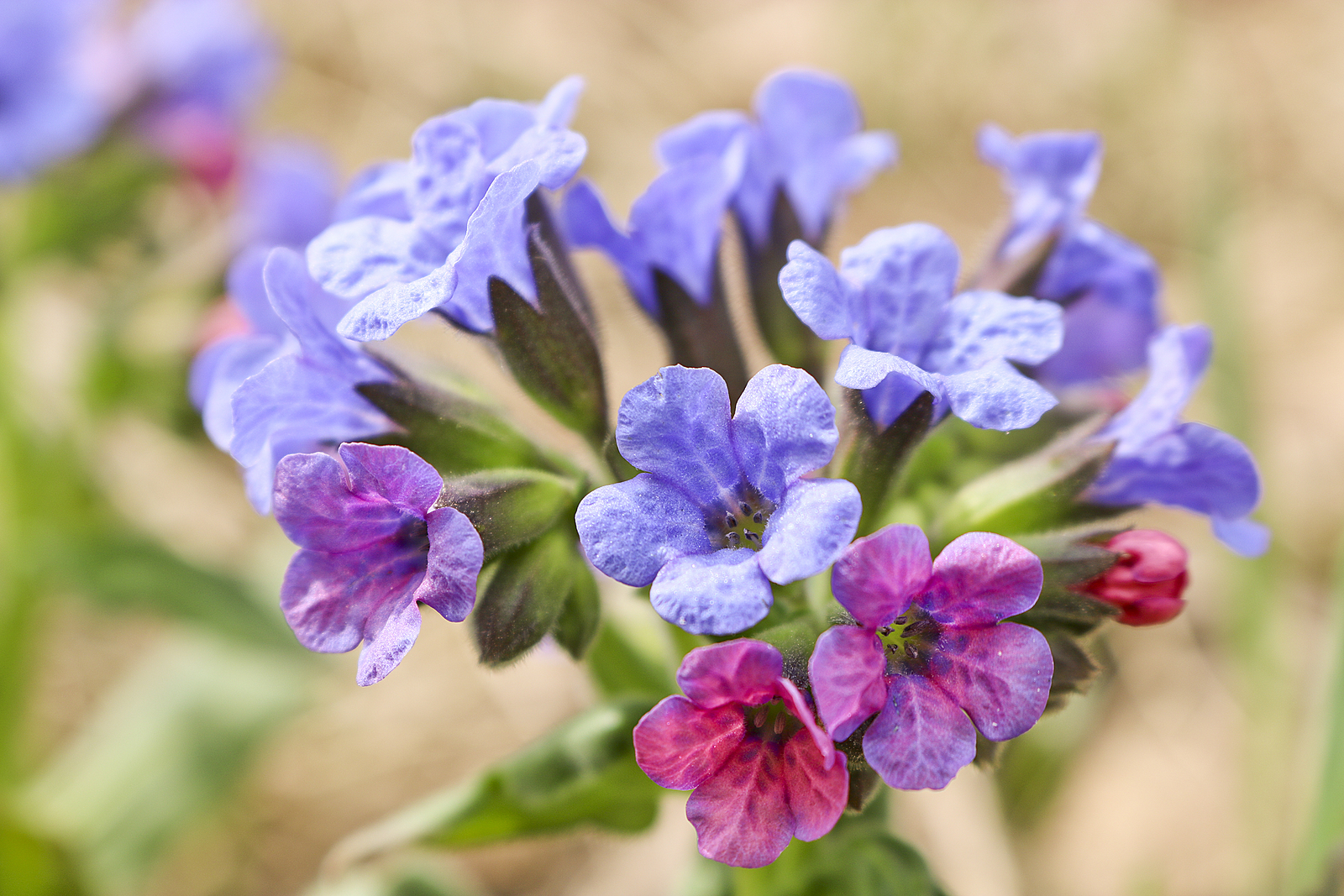 Pulmonaria spp. (lungwort). Dainty drooping clusters of small flowers in mid to late spring; flowers are shades of pink and blue. Grows 8 to 10 inches tall. Grow in the shade where soil will remain moist and cool. Plants spread quite rapidly. Divide plants in late summer.
Pulmonaria spp. (lungwort). Dainty drooping clusters of small flowers in mid to late spring; flowers are shades of pink and blue. Grows 8 to 10 inches tall. Grow in the shade where soil will remain moist and cool. Plants spread quite rapidly. Divide plants in late summer.
Shrubs
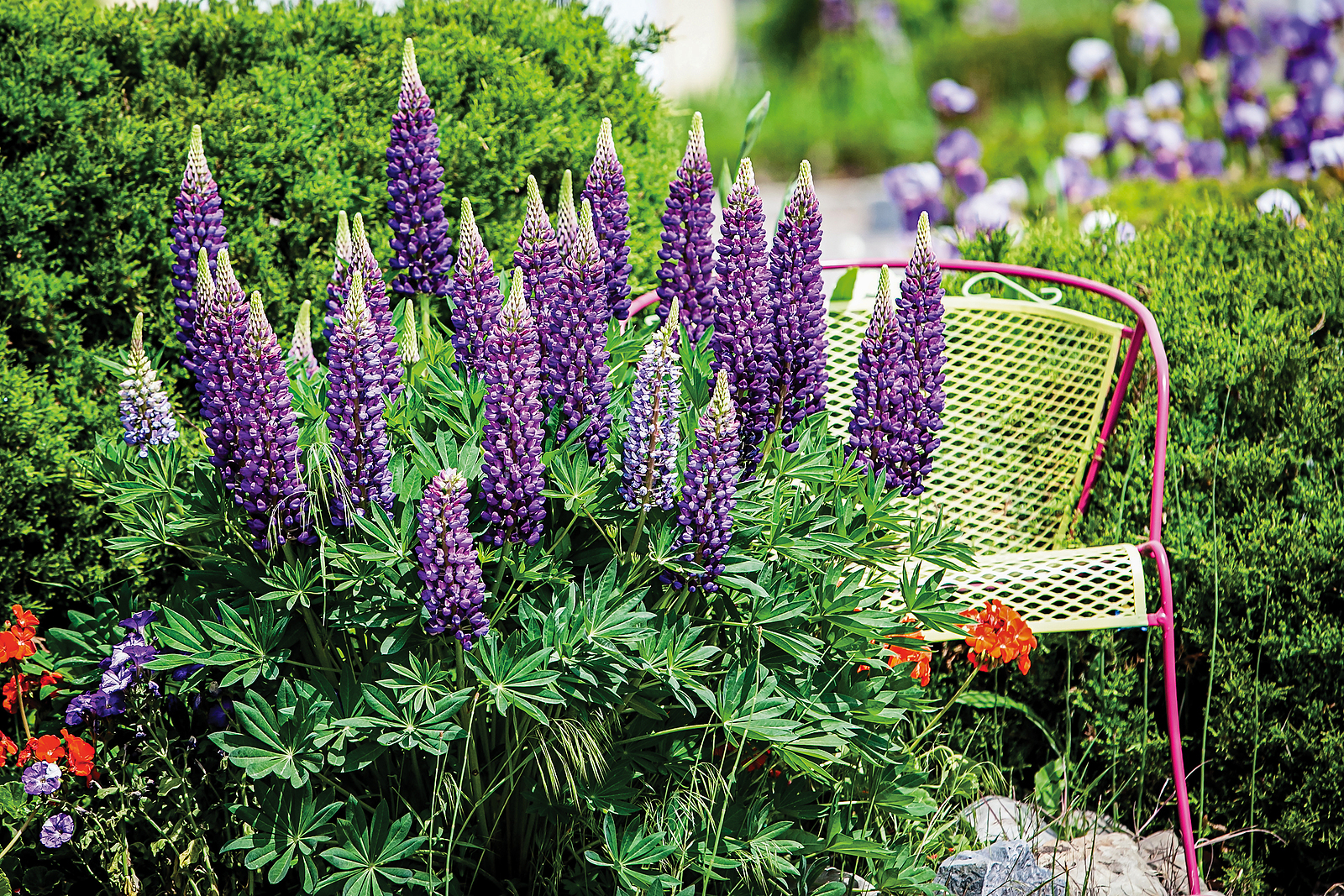 Buddleia davidii (butterfly bush). Lightly scented flowers on long, tapered sprays at branch tips in purple, blue, lavender, pink, and white. Grows vase-shaped to 15 feet tall and 8 feet wide; dwarf cultivar grows 5 to 8 feet tall. Plant in full sun in average to sandy, well-drained soil. Average moisture best; tolerates drought.
Buddleia davidii (butterfly bush). Lightly scented flowers on long, tapered sprays at branch tips in purple, blue, lavender, pink, and white. Grows vase-shaped to 15 feet tall and 8 feet wide; dwarf cultivar grows 5 to 8 feet tall. Plant in full sun in average to sandy, well-drained soil. Average moisture best; tolerates drought.
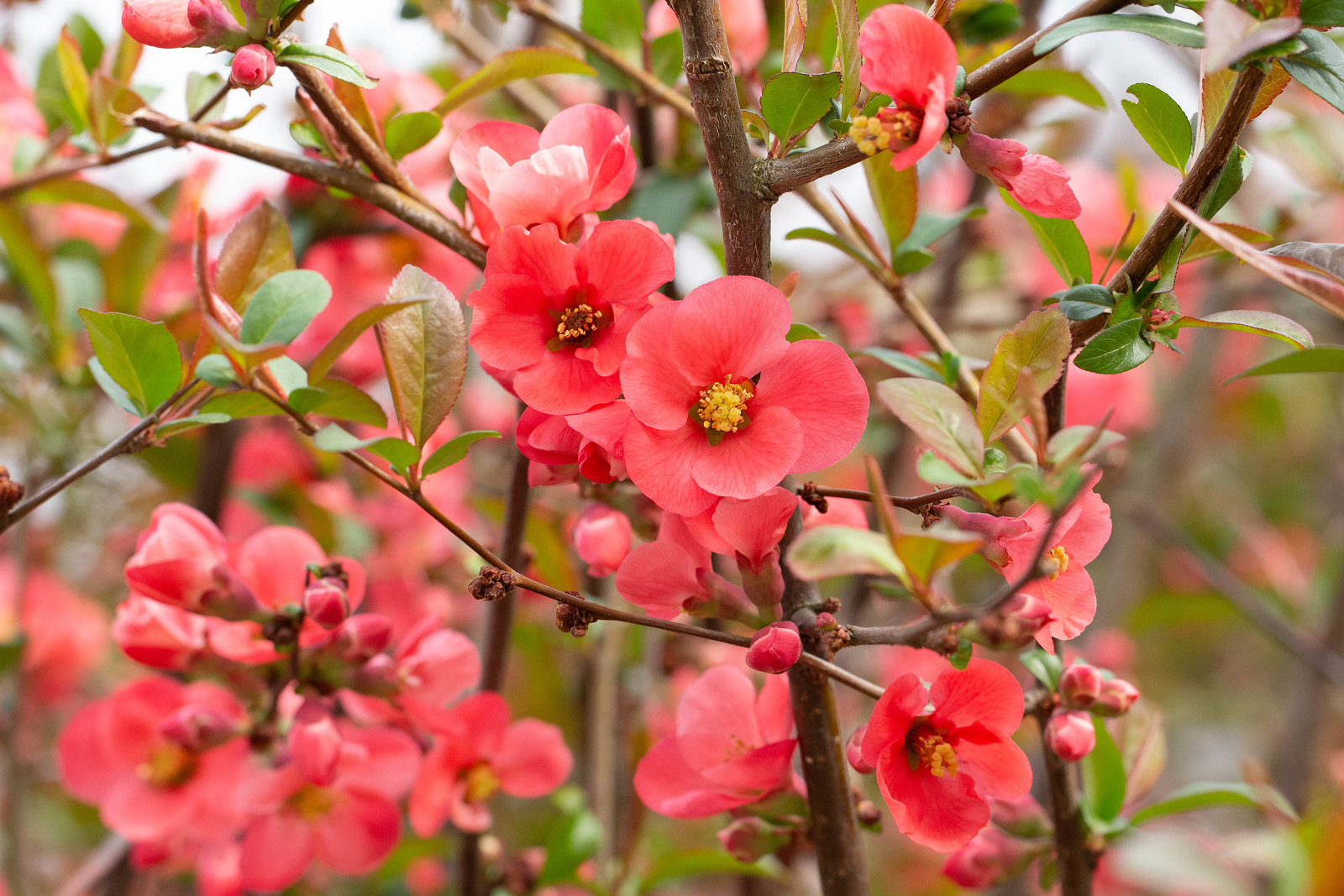 Chaenomeles speciosa (flowering quince). Showy, round satin-petaled flowers 2 inches across; flowers are scarlet, red, pink, or white with yellow centers. Flowers open in spring before leaves mature. Grows 3 to 5 feet tall. Plant in spring, summer, or fall. Propagate from softwood cuttings.
Chaenomeles speciosa (flowering quince). Showy, round satin-petaled flowers 2 inches across; flowers are scarlet, red, pink, or white with yellow centers. Flowers open in spring before leaves mature. Grows 3 to 5 feet tall. Plant in spring, summer, or fall. Propagate from softwood cuttings.
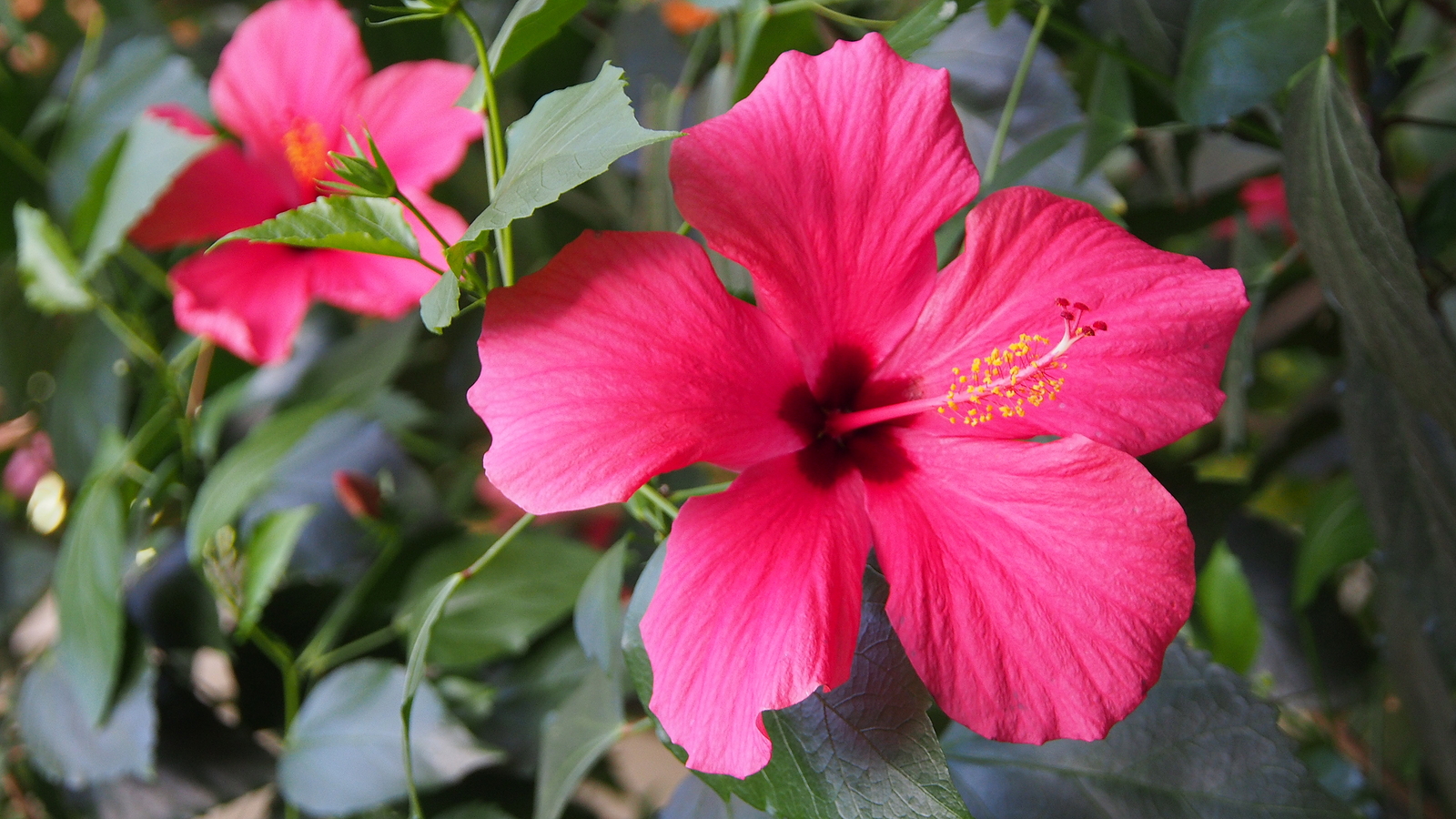 Hibiscus syriacus (rose-of-Sharon). Late summer flowers 2 to 4 inches across resemble hollyhock flowers. Older forms grow to 12 feet tall and 10 feet wide. Plant in full sun to part shade in humus-rich, moist, well-drained soil. Plant in spring or fall.
Hibiscus syriacus (rose-of-Sharon). Late summer flowers 2 to 4 inches across resemble hollyhock flowers. Older forms grow to 12 feet tall and 10 feet wide. Plant in full sun to part shade in humus-rich, moist, well-drained soil. Plant in spring or fall.
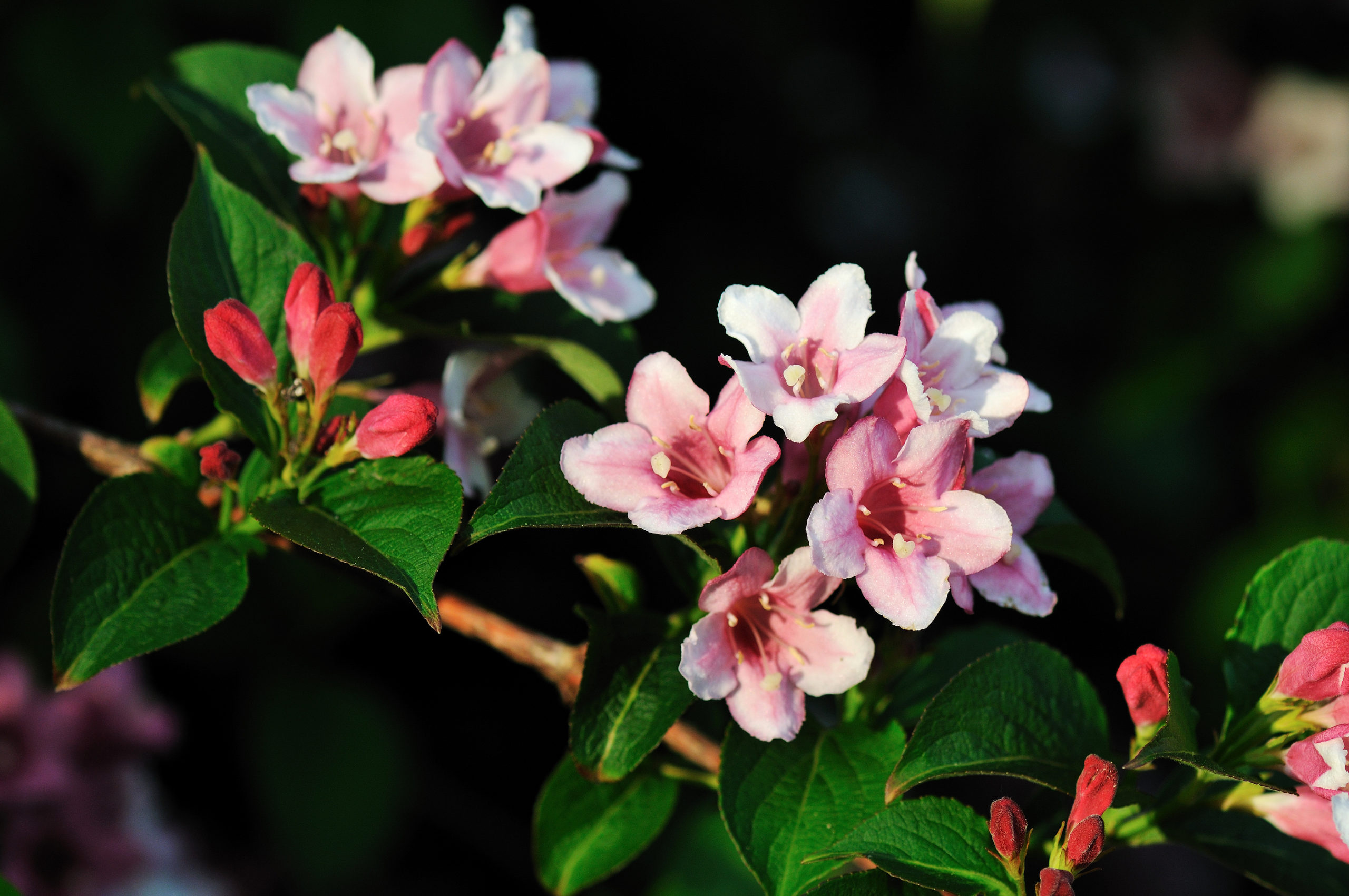 Kolkwitzia amabilis (beautybush). Bell-shaped, 1/2 inch flowers that resemble foxglove are pale pink with yellow speckled throats; blooms in early summer. Vase-shaped shrub grows to 10 feet tall. Plant in full sun in average to humus-rich, well-drained soil. Plant in spring or summer.
Kolkwitzia amabilis (beautybush). Bell-shaped, 1/2 inch flowers that resemble foxglove are pale pink with yellow speckled throats; blooms in early summer. Vase-shaped shrub grows to 10 feet tall. Plant in full sun in average to humus-rich, well-drained soil. Plant in spring or summer.
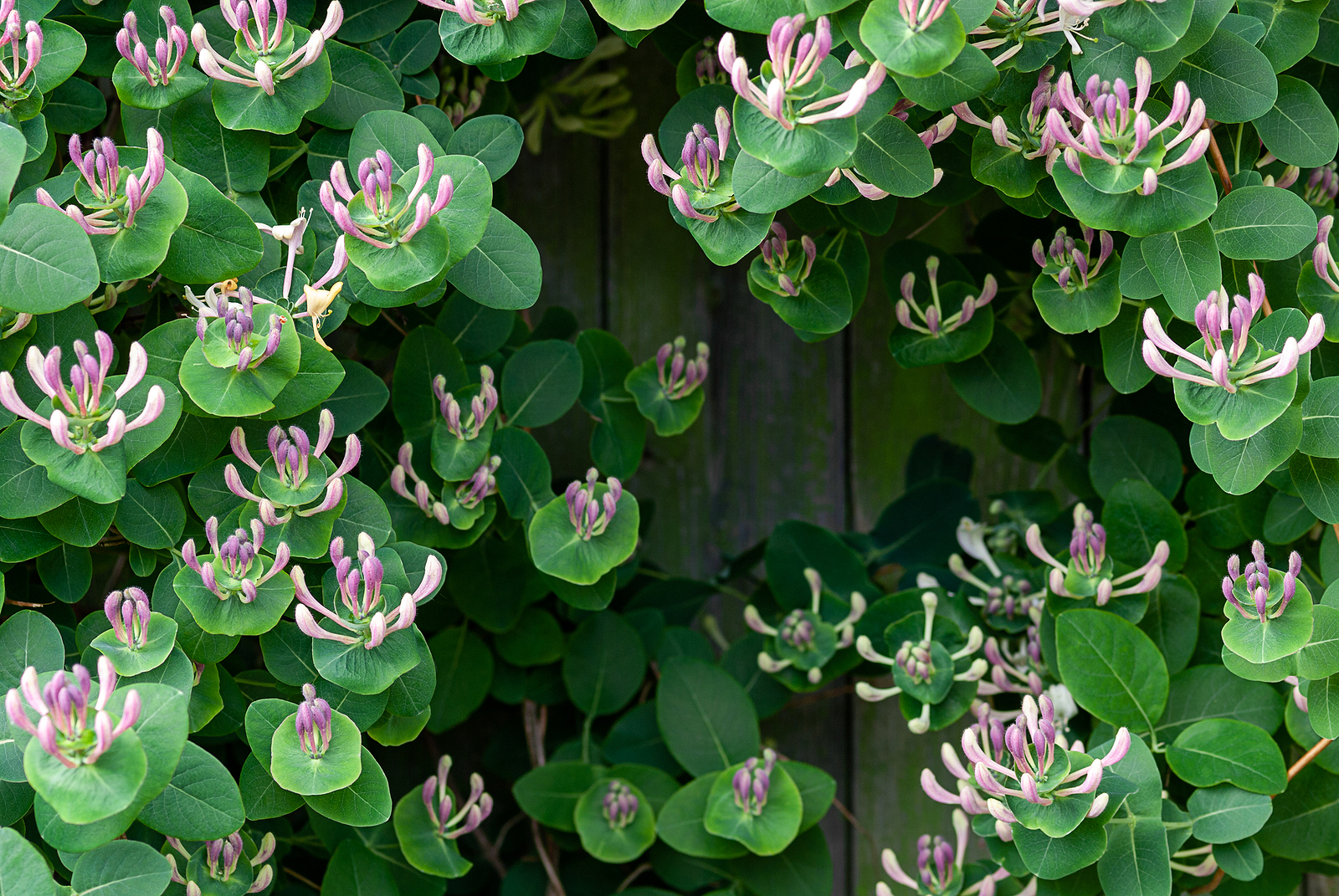 Lonicera tatarica (tatarian honeysuckle). Tubular white to pink or red flowers to 1 inch long are borne profusely along long shoots in late spring and early summer. Grows to 12 feet (4m) tall and 8 feet (2.5m) wide. Plant in full sun or partial shade in humus-rich soil that is moist and well-drained. Plant in spring or fall.
Lonicera tatarica (tatarian honeysuckle). Tubular white to pink or red flowers to 1 inch long are borne profusely along long shoots in late spring and early summer. Grows to 12 feet (4m) tall and 8 feet (2.5m) wide. Plant in full sun or partial shade in humus-rich soil that is moist and well-drained. Plant in spring or fall.
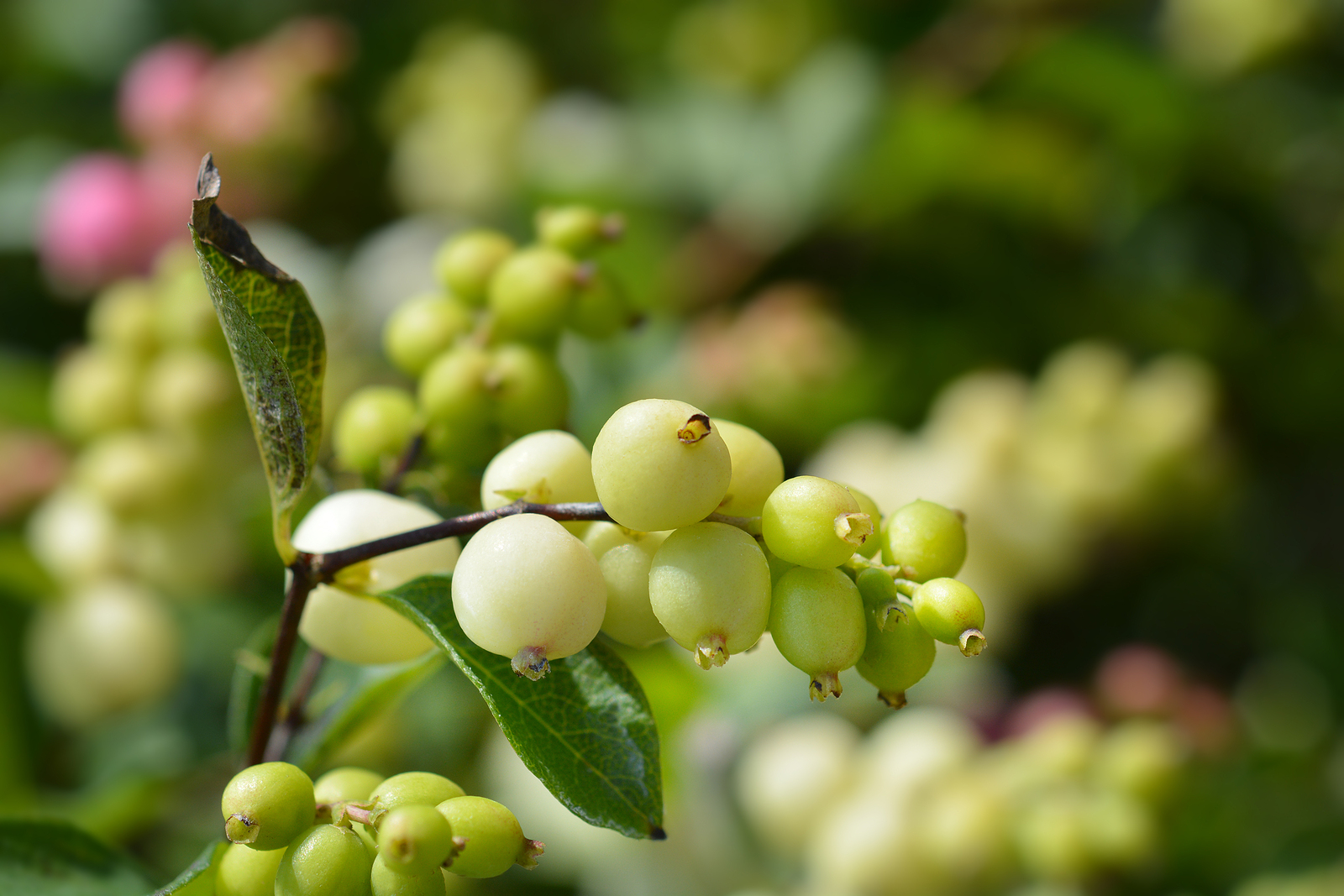 Symphoricarpos chenaultii (Chenault coralberry). Tiny, bell-shaped, reddish-white flowers bloom in summer. Rounded to spreading; 4 to 6 feet tall and wide. Bears snow-white berries which last from fall through winter. Plant in full sun to part shade in average to poor, well-drained soil; tolerates heavy soil. Plant in spring or fall.
Symphoricarpos chenaultii (Chenault coralberry). Tiny, bell-shaped, reddish-white flowers bloom in summer. Rounded to spreading; 4 to 6 feet tall and wide. Bears snow-white berries which last from fall through winter. Plant in full sun to part shade in average to poor, well-drained soil; tolerates heavy soil. Plant in spring or fall.
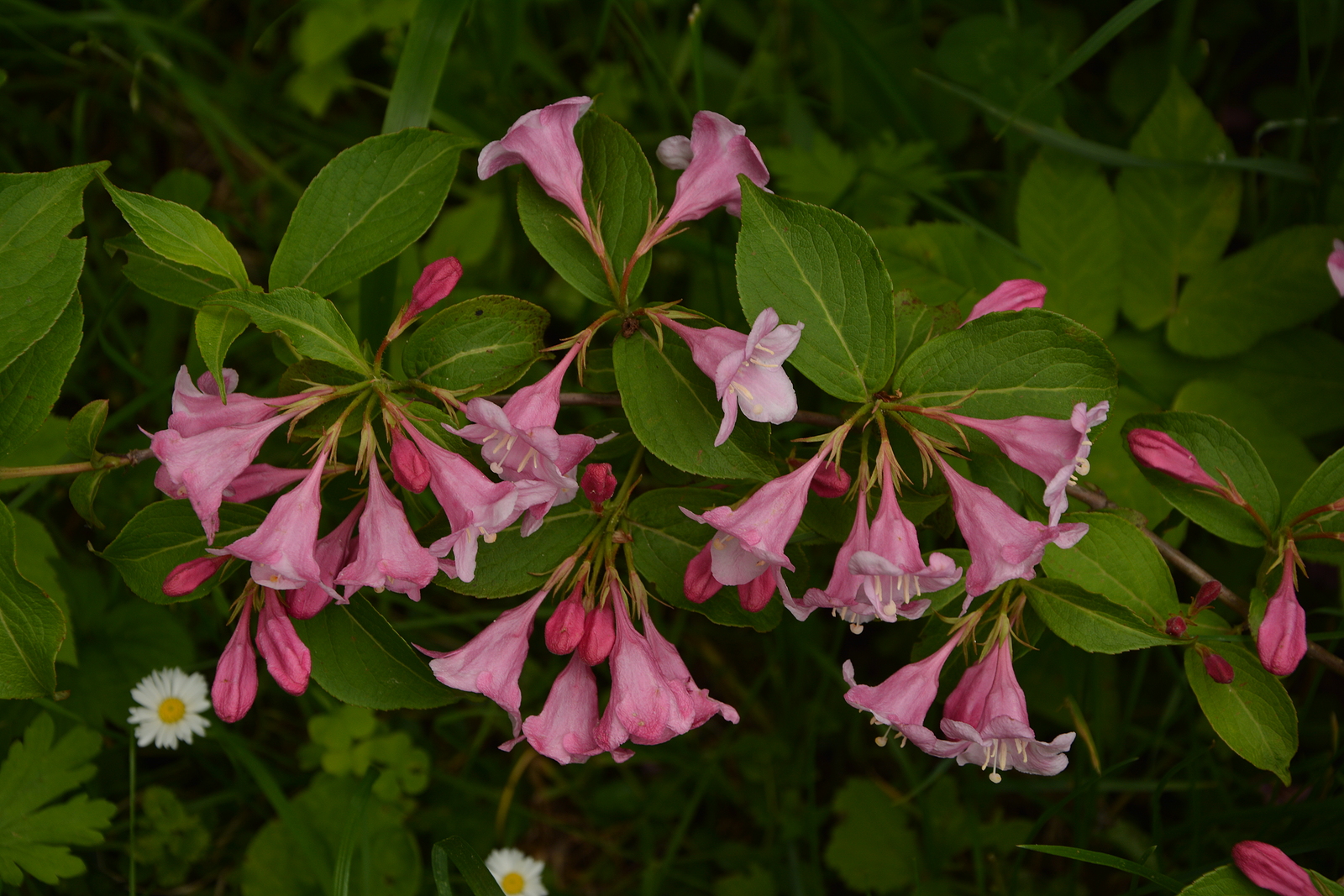 Weigela florida (old-fashioned weigela). Bears funnel-shaped, 1-inch-long, pink, rose-red, or white blossoms in clusters along the stems. Blooms in late spring and early summer; may bloom again lightly in fall. Vase-shaped to rounded with long arching branches 6 to 9 feet tall and 9 to 12 feet wide. Plant in full sun or half shade; best in well-drained, humus-rich soil.
Weigela florida (old-fashioned weigela). Bears funnel-shaped, 1-inch-long, pink, rose-red, or white blossoms in clusters along the stems. Blooms in late spring and early summer; may bloom again lightly in fall. Vase-shaped to rounded with long arching branches 6 to 9 feet tall and 9 to 12 feet wide. Plant in full sun or half shade; best in well-drained, humus-rich soil.
Trees
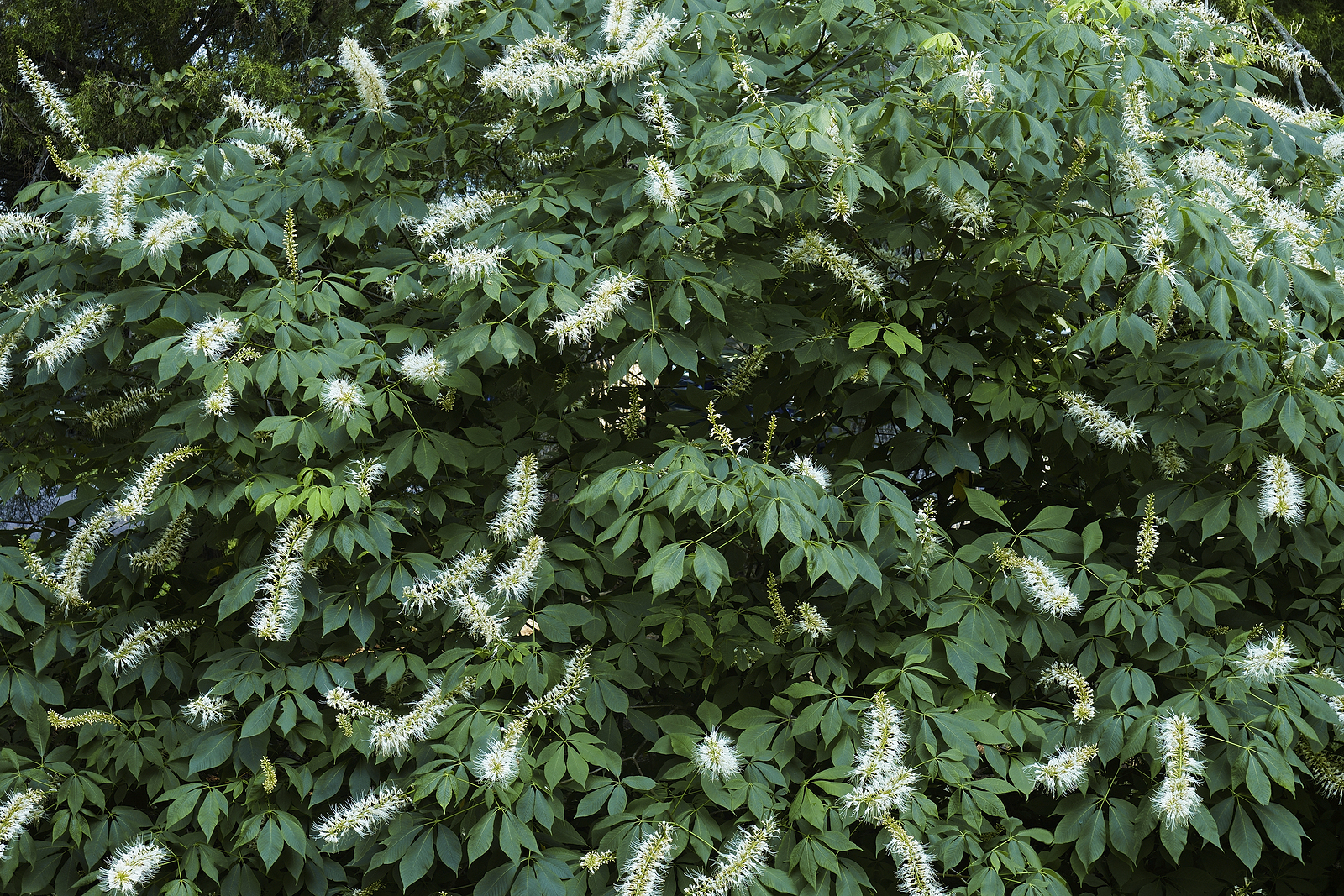 Aesculus glabra (Ohio buckeye). Broadly conical–rounded tree with light green long-pointed 5-palmate leaflets. In spring, it bears yellow-green flowers in conical panicles. Grows to 50 feet tall and 30 feet wide. Best in Zones 3 to 7.
Aesculus glabra (Ohio buckeye). Broadly conical–rounded tree with light green long-pointed 5-palmate leaflets. In spring, it bears yellow-green flowers in conical panicles. Grows to 50 feet tall and 30 feet wide. Best in Zones 3 to 7.
 Albizia julibrissin (silk tree). Dark green fern-like leaves turn pale yellow in autumn. Clusters of greenish-yellow flowers appear in summer. Grows 20 feet tall and 12 to 20 feet wide. Plant in a protected location. Best in Zones 7 to 10.
Albizia julibrissin (silk tree). Dark green fern-like leaves turn pale yellow in autumn. Clusters of greenish-yellow flowers appear in summer. Grows 20 feet tall and 12 to 20 feet wide. Plant in a protected location. Best in Zones 7 to 10.
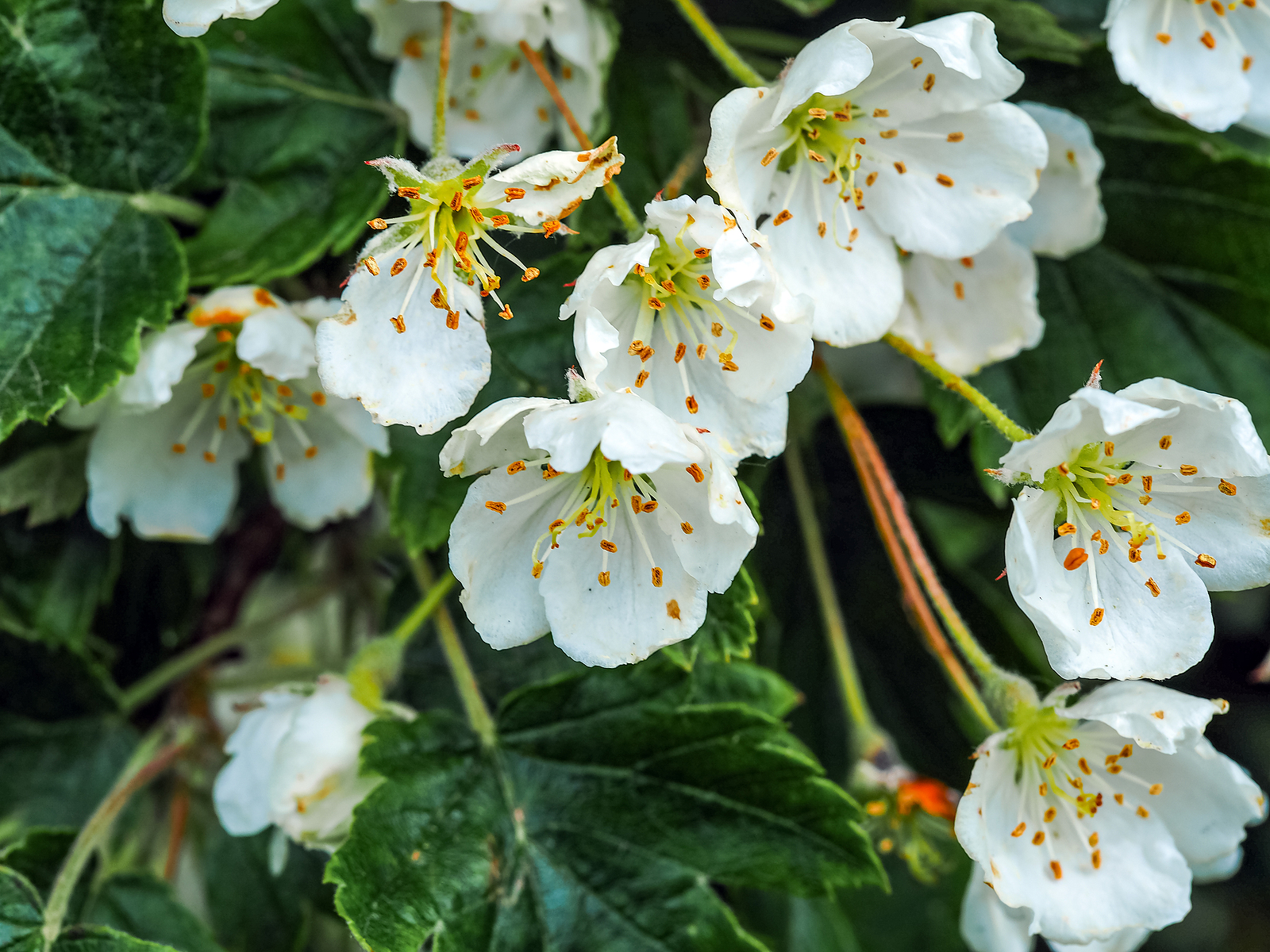 Crataegus phaenopyrum (Washington hawthorn). Rounded, slender, thorny deciduous tree with maple-like deeply 3-lobed leaves. Glossy mid-green, turning orange to red in autumn. In early mid-summer bears many-flowered corymbs of white blossoms. Best in Zones 4 to 8.
Crataegus phaenopyrum (Washington hawthorn). Rounded, slender, thorny deciduous tree with maple-like deeply 3-lobed leaves. Glossy mid-green, turning orange to red in autumn. In early mid-summer bears many-flowered corymbs of white blossoms. Best in Zones 4 to 8.
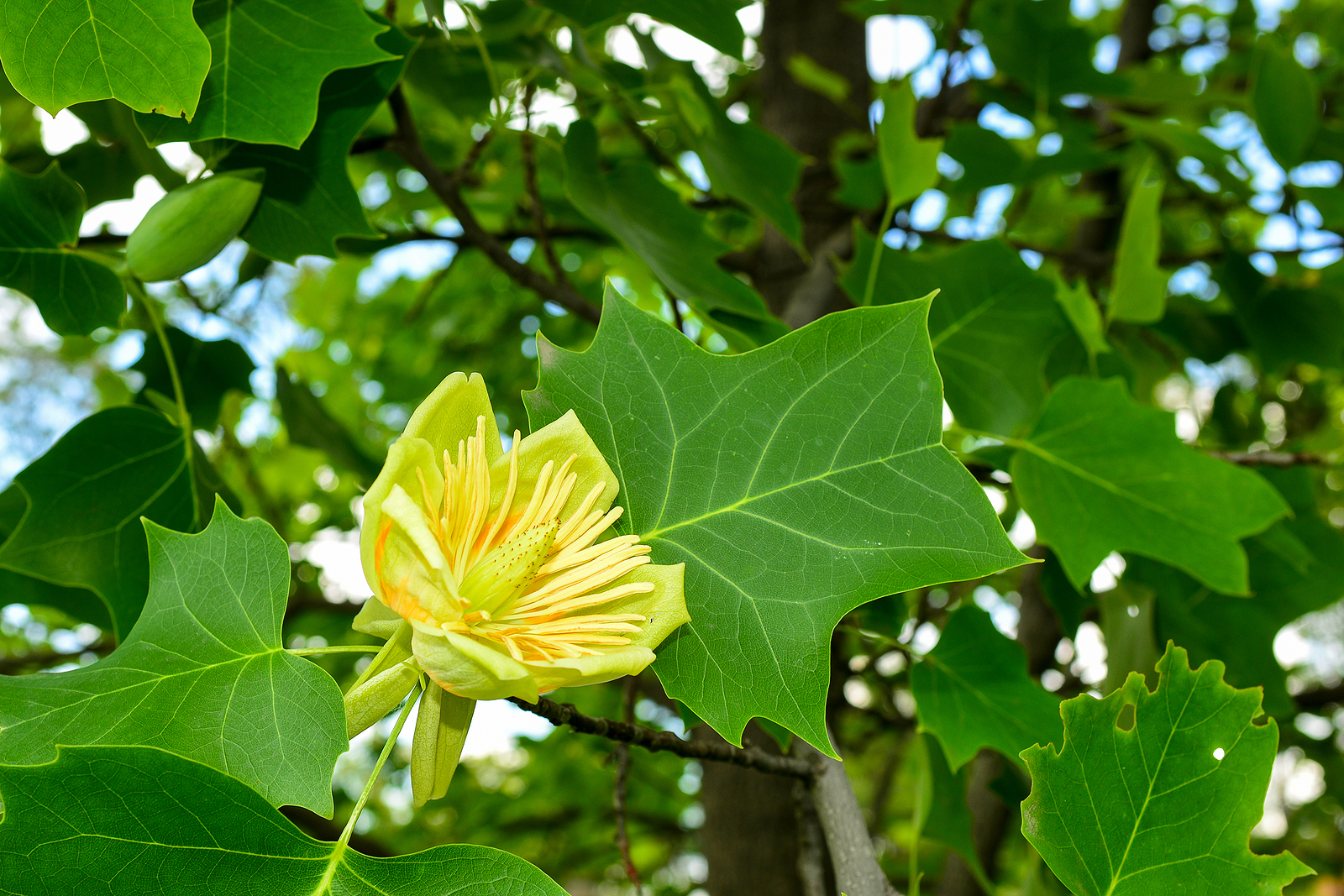 Liriodendron tulipifera (tulip tree). Large tree sheds its lower branches as it ages. Dark green leaves are shallowly lobed and turn yellow in autumn. Bears yellow-green tulip-like flowers in spring. Grows 115 feet (35m) tall and 50 to 65 feet (15-20m) wide. Best in Zones 4 to 9.
Liriodendron tulipifera (tulip tree). Large tree sheds its lower branches as it ages. Dark green leaves are shallowly lobed and turn yellow in autumn. Bears yellow-green tulip-like flowers in spring. Grows 115 feet (35m) tall and 50 to 65 feet (15-20m) wide. Best in Zones 4 to 9.
 Malus floribunda (Japanese flowering crabapple). Graceful, broadly spreading tree has lobed, dark green leaves. In mid-spring it is covered with crimson buds from which open white or pale pink flowers. Grows 16 feet (5m) tall and wide. Best in Zones 4 to 7.
Malus floribunda (Japanese flowering crabapple). Graceful, broadly spreading tree has lobed, dark green leaves. In mid-spring it is covered with crimson buds from which open white or pale pink flowers. Grows 16 feet (5m) tall and wide. Best in Zones 4 to 7.
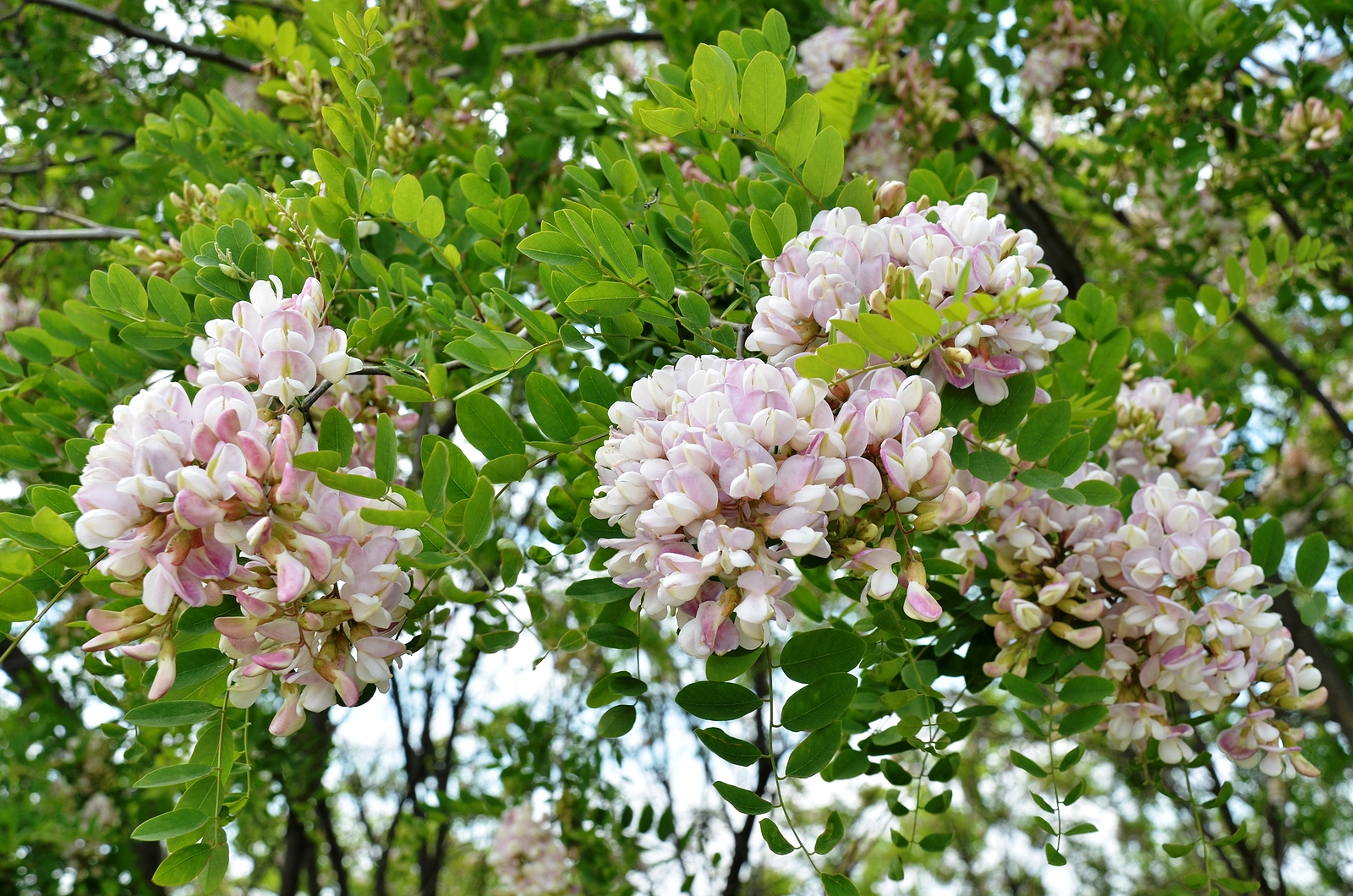 Robinia pseudoacacia (black locust). Broadly columnar tree has feathery green pinnate leaves. In warm summers fragrant white flowers are borne in long racemes. Grows 80 feet (25m) tall and 50 feet (15m) wide. Best in Zones 4 to 8.
Robinia pseudoacacia (black locust). Broadly columnar tree has feathery green pinnate leaves. In warm summers fragrant white flowers are borne in long racemes. Grows 80 feet (25m) tall and 50 feet (15m) wide. Best in Zones 4 to 8.
Vines
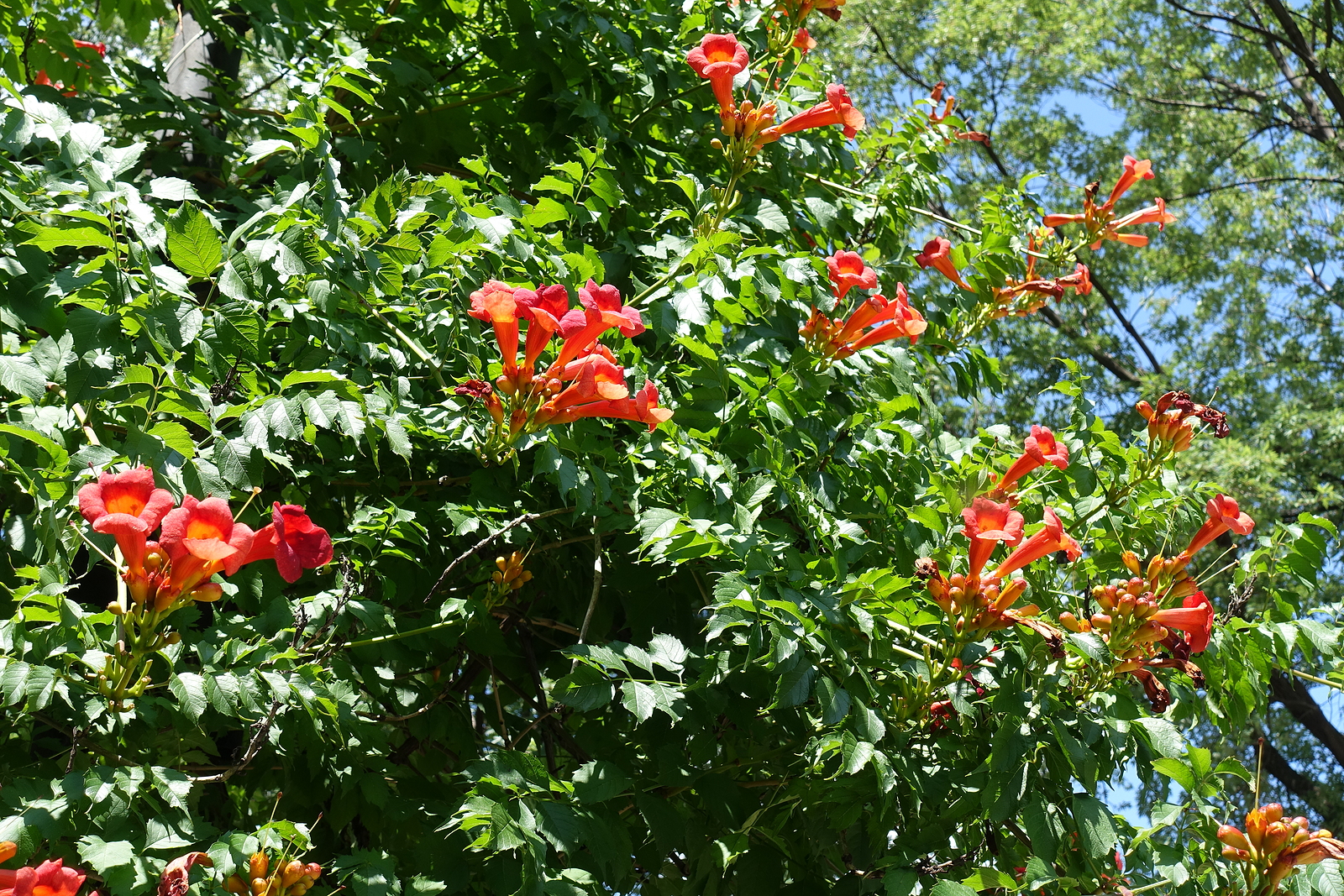 Campsis radicans (trumpet creeper). Fast grower has compound leaves and vivid orange-red trumpetlike flowers. Rootlets along stems attach to supports. Grows 15 to 20 feet tall and wide
Campsis radicans (trumpet creeper). Fast grower has compound leaves and vivid orange-red trumpetlike flowers. Rootlets along stems attach to supports. Grows 15 to 20 feet tall and wide
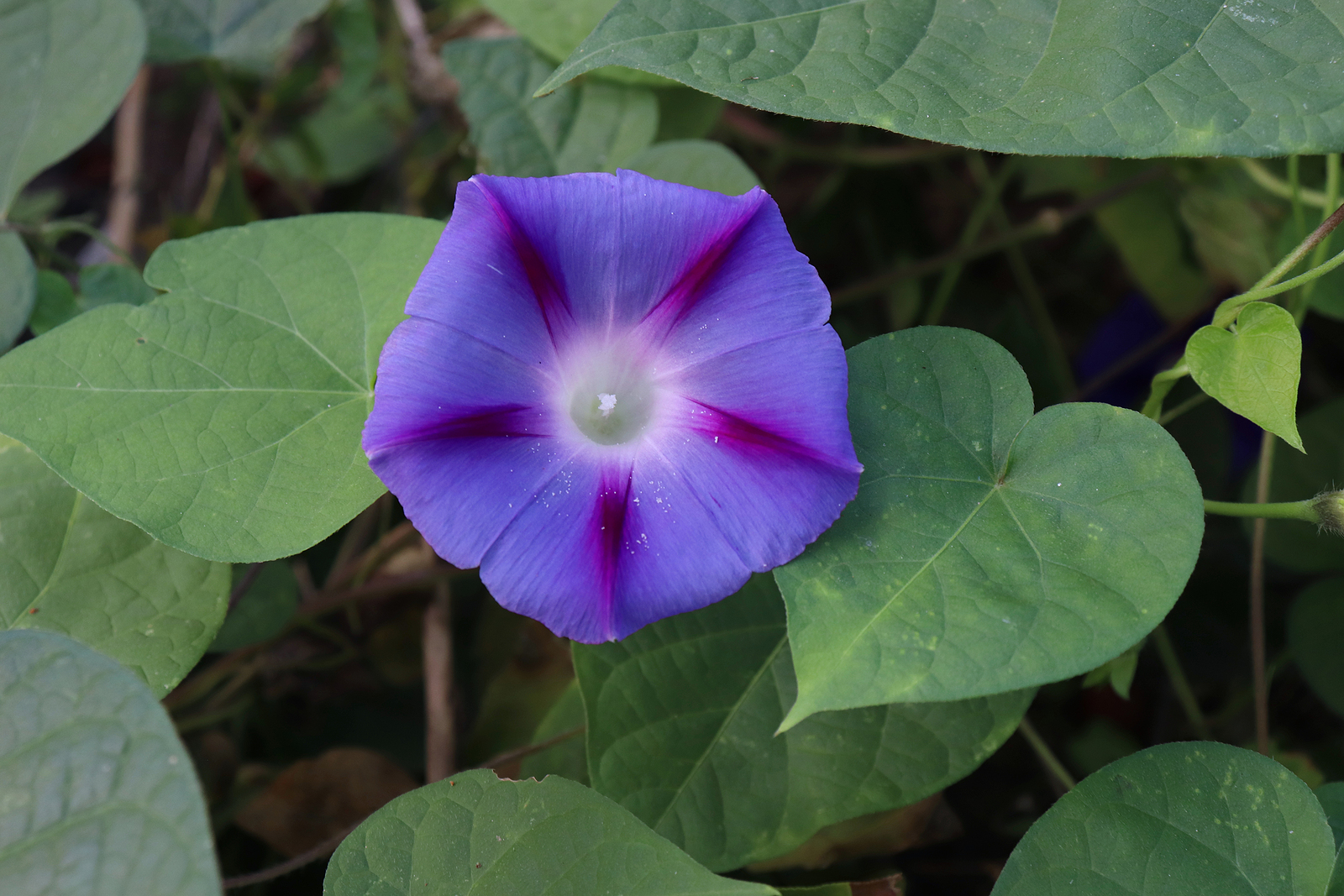 Ipomoea spp. (cardinal climber, morning glory). Trailing and climbing vines bear funnel-shaped or tubular flowers of many colors. Best planted in a protected area. Grows 6 to 15 or more feet tall and wide depending on the variety. Grow as an annual or as a perennial in mild-winter regions.
Ipomoea spp. (cardinal climber, morning glory). Trailing and climbing vines bear funnel-shaped or tubular flowers of many colors. Best planted in a protected area. Grows 6 to 15 or more feet tall and wide depending on the variety. Grow as an annual or as a perennial in mild-winter regions.
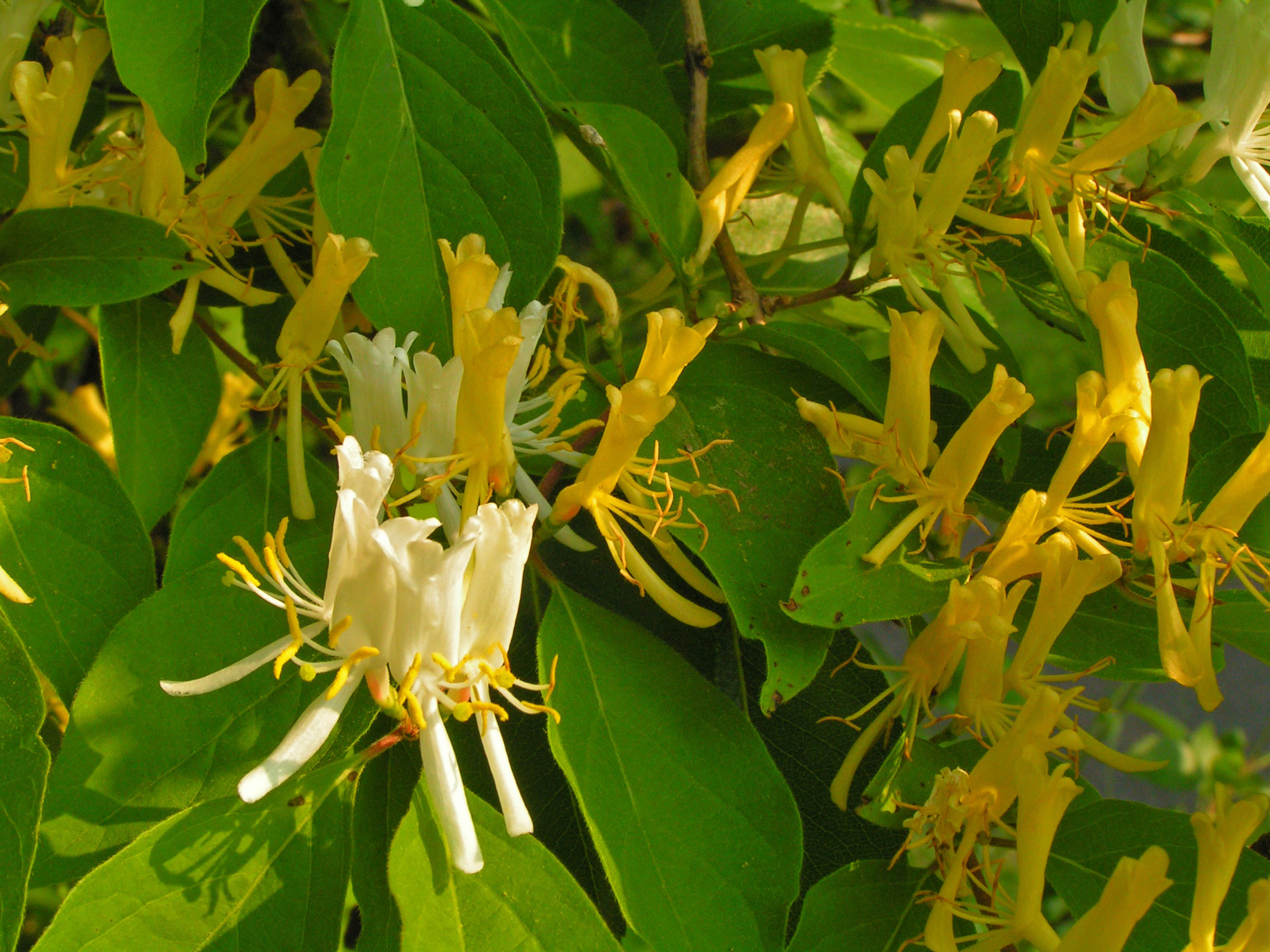 Lonicera sempervirens (trumpet honeysuckle). Tubular usually red-orange flowers form in clusters at the ends of side shoots that appear in summer. Can be trained to a wall or fence or onto a large shrub or small tree. Grows 12 to 20 feet tall and wide.
Lonicera sempervirens (trumpet honeysuckle). Tubular usually red-orange flowers form in clusters at the ends of side shoots that appear in summer. Can be trained to a wall or fence or onto a large shrub or small tree. Grows 12 to 20 feet tall and wide.
Also of interest:
20 Flowers That Attract Hummingbirds















